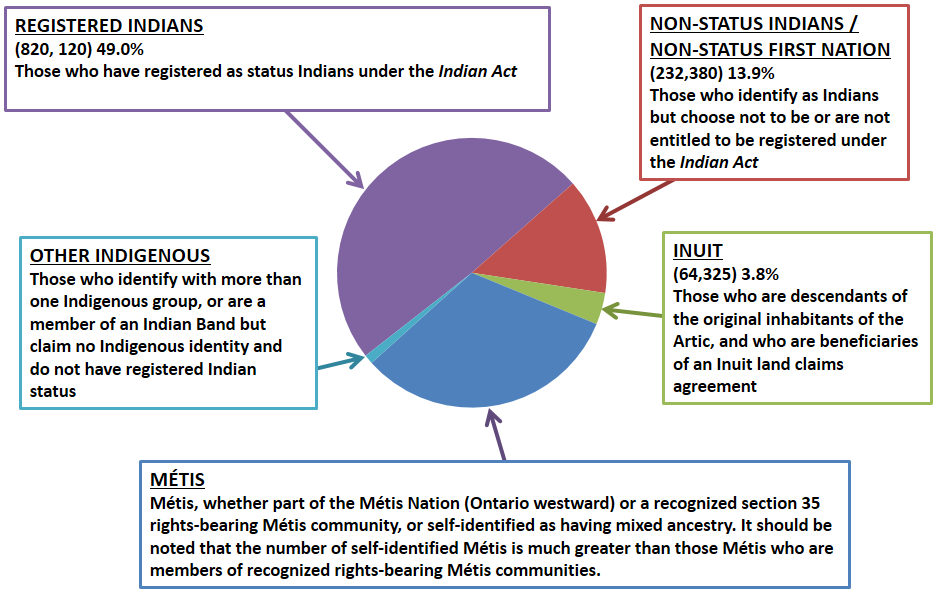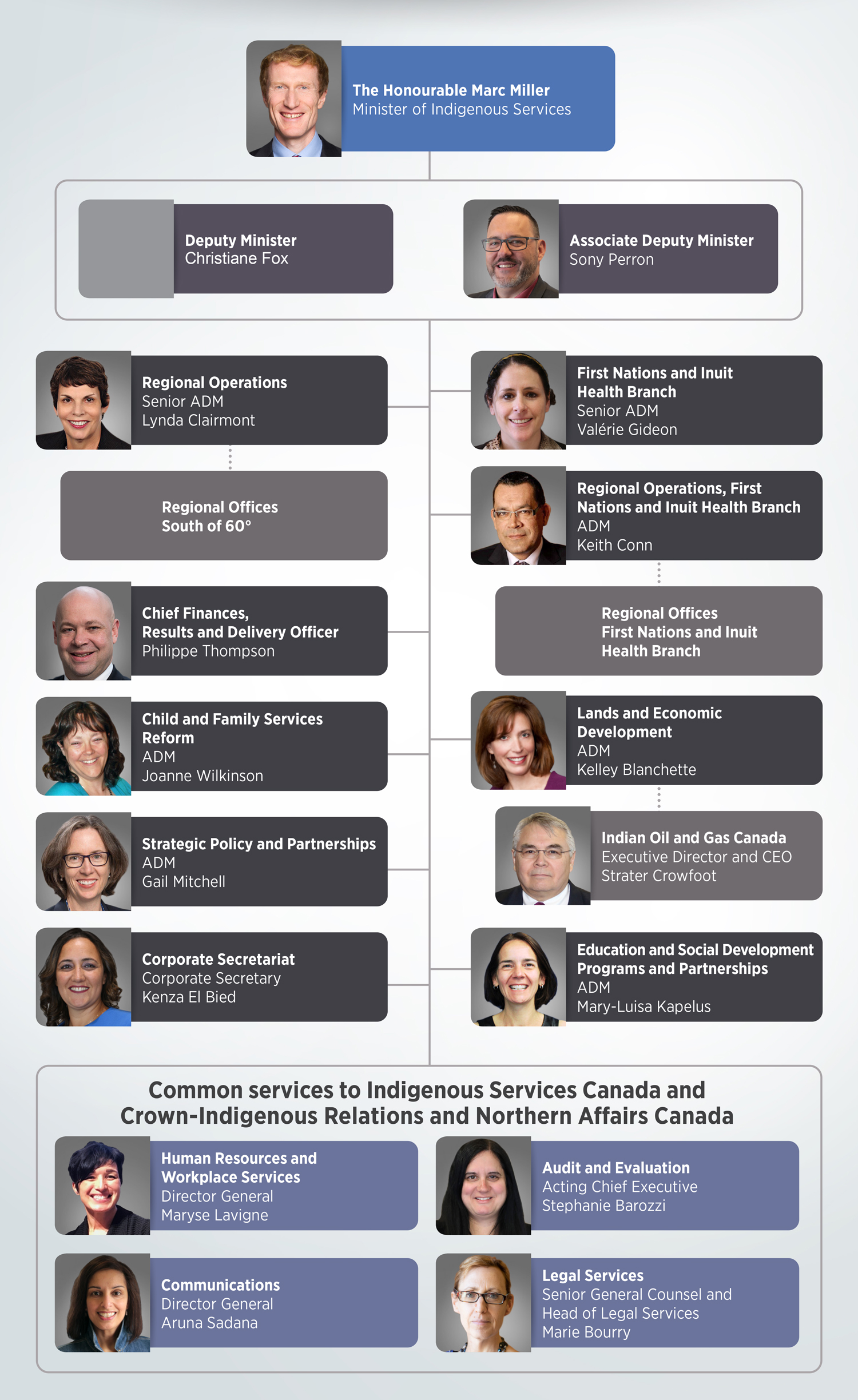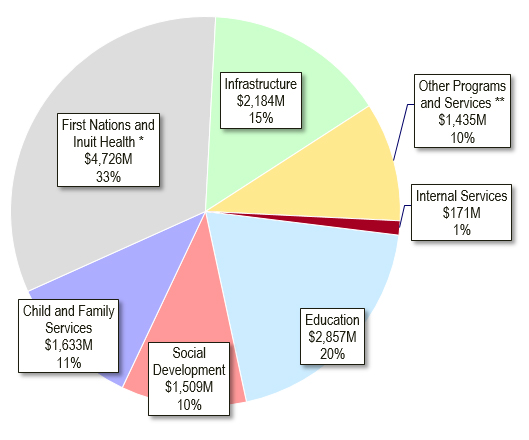Transition 2020 Deputy Minister Fox Indigenous Services Canada overview - Book 1
Table of contents
PART A
Indigenous Peoples of Canada: An Overview
Who are the Indigenous Peoples of Canada?

- Original inhabitants of what is now Canada
- First Nations and Inuit: ancestors pre-date arrival of Europeans
- Métis Nation: emerged as distinct, mixed-ancestry people from interactions between Europeans and First Nations (primarily in Ontario westward)
- First Nations, Inuit and Métis have some shared experiences, but all have unique cultures and identities Indigenous identities are highly diverse even within First Nations. Each Indigenous nation and community has its own customs and traditions.
- More than 70 Indigenous languages reported in the 2016 Census (see Annex A)
Indigenous Populations in Canada

Description of Indigenous Populations in Canada
The pie chart shows the population of Registered Indians; non-status Indians / non-status First Nations; Inuit; Métis; and other Indigenous identities as a proportion of the total Indigenous population in Canada.
Numerical values presented in the chart:
| Indigenous identity | Description | Population | Proportion of Indigenous population |
|---|---|---|---|
| Registered Indians | Those who have registered as status Indians under the Indian Act. | 820,120 | 49.0% |
| Non-status Indians / Non-status First Nations | Those who identify as Indians but choose not to be or are not entitled to be registered under the Indian Act. | 232,380 | 13.9% |
| Inuit | Those who are descendants of the original inhabitants of the Arctic, and who are beneficiaries of an Inuit land claims agreement. | 64,325 | 3.8% |
| Métis | Métis, whether part of the Métis Nation (Ontario westward) or a recognized section 35 rights-bearing Métis community, or self-identified as having mixed ancestry. It should be noted that the number of self-identified Métis is much greater than those Métis who are members of recognized rights-bearing Métis communities. | 537,855 | 32.1% |
| Other Indigenous | Those who identify with more than one Indigenous group, or are a member of an Indian Band but claim no Indigenous identity and do not have registered Indian status. | 19,100 | 1.1% |
History of Indigenous Policy in Canada
Early Contacts
- First Nations people and Inuit lived in what is present day Canada at time of contact
- Encountered settlers from 1534 to the early 1900s
- Engaged in trade, military alliances and Peace and Friendship Treaties
- Unions between First Nations women and settlers created a distinct Métis culture
Colonial and Canadian Era
- Royal Proclamation, 1763: British Crown acknowledge Indigenous rights to lands, established protocols for treaty-making and formalized the Crown-Indigenous relationship. A series of land surrender treaties are concluded in what is now Southern Ontario.
- After being considered military allies, Indigenous peoples were increasingly viewed as a detriment to the proper development of the colonies
- Policies of Civilization 1820s: new policies are put in place to create reserves lands for First Nations while encouraging Indigenous communities to abandon traditional ways of life for one more similar to that of British settlers.
- Education and lands 1840s and 1850s: increased efforts are placed on establishing schools for Indigenous children and the imposition of settler concepts of land ownership
- British North America Act, 1867: section 91(24) assigns federal jurisdiction over "Indians, and lands reserved for the Indians"
- Numbered Treaties, 1871-1921: 11 numbered treaties signed in ON, MB, BC, AB, Yukon and NWT for respectful co-existence, some treaties included socio-economic provisions, such as a medicine chest, schools or economic means (e.g. "cows and plows")
- Indian Act established in 1876 as a means of assimilation which led to direct control of communities and reserves, imposition of education systems, controlled movement of Indians through pass system, gender discrimination against women who married non-Indigenous men and loss of status via enfranchisement.
- Indian Act provides legislative mechanism for the imposition of assimilationist and destructive policies and programs
- Paternalism 1880s-1950s: despite the creation of wide-ranging social, health-care and education programs, the core activities of the Department focus on efforts to control Indigenous peoples such as through residential schools and forced relocations
Activism & Rights Assertions
- 1940s: in the post-war period, regional Indigenous organizations are formed to advocate for changes to policies and improvements to the deteriorating state of Indigenous communities
- 1969: White Paper – federal policy statement intended to repeal the Indian Act and assimilate Indigenous peoples into broader Canadian society; Indigenous peoples responded with Red Paper for recognition of Indigenous peoples and their treaty rights
- 1971: National Indian Brotherhood, later Assembly of First Nations (AFN), provides Canada-wide representation of Indigenous Peoples. 1971 also marks the creation of Inuit Tapiriit Kanatami (ITK), the primary organization representing Inuit in Canada, out of concerns of Inuit leaders regarding land and resource ownership in Inuit Nunangat.
- 1983:Creation of the Métis National Council, the organization representing the Métis Nation nationally and internationally.
Recognition
- Modern Treaties 1873: The Calder decision of 1973 pushes the Federal Government to recognize outstanding Indigenous rights over lands and the adoption of the comprehensive land claims process to negotiate new treaties with Indigenous communities.
- Section 35 of Constitution Act, 1982, recognizes and affirms Aboriginal and treaty rights of Indigenous peoples (defined as First Nations, or "Indians," Inuit and Métis)
- Indigenous peoples advocated for their recognition during attempted Meech Lake Accord, 1990 and Charlottetown Accord, 1992
- 1991-1996: Royal Commission on Aboriginal Peoples made 350 recommendations, including the enactment of legislation and creation of institutions that would provide the authority for Indigenous peoples' self-determination
Devolution & Community-based Services
- Indigenous Control 1970s-80s: Federal programs and policies are changed to allow for increased local control by community governments, starting with schools and education services in the 1970s and later for band governance in the 1980s.
- Indian Health Policy, 1979: Development of a new policy approach to First Nation health-care that focuses on a more inclusive and community led services
- Cree Naskapi Act, 1984 and Sechelt Indian Band Self-Government Act, 1986: first agreements to pull First Nations outside of Indian Act to create self-government
- Inherent Right Policy, 1995: Establishment of a negotiated process to establish self-government agreements resulted in 22 agreements across 43 communities, and is a central component to Modern Treaties.
- First Nations Land Management Act, 1999: Creation of a regime for First Nations to opt-out of 40 Indian Act provisions on land, environment and resources, to develop their on land and resources management codes. Similar regimes have since been established in a range of areas including fiscal management, First Nations elections, commercial development and oil and gas management.
Modernizing Services
- The Truth and Reconciliation Commission examining the impacts of Residential Schools issues 94 Calls to Action to guide the reconciliation between Indigenous and non-Indigenous peoples in Canada
- 2017: Announcement of the dissolution of Indigenous and Northern Affairs Canada (INAC) and creation of two new departments: Indigenous Services Canada (ISC) and Crown-Indigenous Relations and Northern Affairs Canada (CIRNAC)
- ISC is committed to supporting and empowering Indigenous control over delivery of services and improving socio-economic conditions and quality of life in First Nations, Inuit and Métis communities; key to Indigenous self-determination
- 2019: A legislative mandate for ISC to work towards the transfer of departmental responsibilities and collaborate with Indigenous partners in all aspects of service delivery.
Demographic Trends
- In 2016, there were 1,673,785 Indigenous people in Canada, accounting for 4.9% of the total population
- Indigenous population has increased from 1,172,790 in 2006
- A rate 4 times greater than non-Indigenous population
- Between 2006 and 2016:
- First Nations population grew by 39.3% to 977,230 people
- Métis population grew by 51.2% to 587,545 people*
- Inuit population grew by 29.1% to 65,025 people
- As of 2016, 4 in 10 registered Indians live on reserve (331,030)
- Increase from 2011 when 315,995 registered Indians lived on reserve
- 49,335 non-registered Indians living on reserve
- 57.9% of Indigenous peoples reported living in urban areas in 2016
- There is a growing population of Indigenous children and youth
- Children between age 0-14 make up 26.8% of the total population
- Youth aged 15-24 make up 16.9% of the population
- In the next two decades, the Indigenous population is likely to exceed 2.5 million persons
* The growth in the Métis population is not solely due to natural growth but rather an increase in the number of individuals self-identifying as Métis, whether or not they are members of a rights-bearing Métis community.
Current Gaps and Challenges
Housing
There continues to be substandard housing and infrastructure. 6.0% of the non-Indigenous population lived in a dwelling in need of major repairs in 2016. This compares to:
- First Nations: One quarter (24.2%)
- Inuit: One‑quarter (26.2%)
- Métis: One‑tenth (11.3%)
The proportion of non-Indigenous people who lived in housing that was crowded was 8.5% in 2016. This compares to:
- First Nations: 23.1.%
- Inuit: 51.7% in Inuit Nunangat (10.9% outside Inuit Nunangat)
- Métis: 8.6%
Health and Social
From 2011-2016, Statistics Canada data indicated that the suicide rate among non-Indigenous Canadians was 8 deaths per 100,000 person-years at risk (number of deaths per person per year). This compares to:
- First Nations: First Nations people was three times higher at 24.3 deaths per 100,000 person-years at risk. The suicide rate for First Nations people living on a reserve was twice as high than those living off reserve, according to the agency.
- Inuit: The rate for Inuit was around nine times higher than non-Indigenous, at 72.3 deaths per 100,000 person-years at risk.
- Métis: The rate for Métis was around twice as high as the rate of non-Indigenous people, at 14.7 deaths per 100,000 person-years at risk).
Indigenous children currently represent 52.2% of children in foster care while accounting for 7.7% of the overall population of children under 15.
Employment
Employment rates were 62.7% in 2006 and 60.5% in 2016 for Canada's non-Indigenous population. This compares to:
- First Nations: Employment rate for First Nations on reserve decreased from 39.0% in 2006 to 36.3% in 2016. For First Nations off reserve, the employment rate decreased from 54.9% in 2006 to 52.0% in 2016.
- Inuit: Employment rate for Inuit increased from 48.9% in 2006 to 49.0% in 2016.
- Métis: Employment rate for Métis decreased from 63.1% in 2016 to 60.3% in 2016.
Education
There remain persistent gaps in educational attainment. The non-Indigenous population with high school education or higher was 89.2% in 2016. This compares to:
- First Nations: 57.0% of First Nation people living on reserve.
- Inuit: 47.1% Inuit inside Inuit Nunangat.
- Métis: 80.3% Métis, who completed high school in 2016.
From 2006 to 2016, the proportion of non-Indigenous Canadians with university (bachelor or higher) education increased from 23.4% in 2006 to 29.3% in 2016. This compares to:
- First Nations: First Nations people on reserve with university-level education was 4.3% in 2006 and 5.4% in 2016. For First Nations people off reserve, those with university education was 9.2% in 2006 and 11.3% in 2016.
- Inuit: Inuit inside Inuit Nunangat with university education remained constant at 2.4%. Inuit outside Inuit Nunangat with university education was 8.5% in 2006 and 12.0% in 2016.
- Métis: Métis with university-level education was 9.2% in 2006 and 13.6% in 2016.
Income
Incomes remain below average. The average income of the non-Indigenous population in 2015 was $47,981. This compares to:
- First Nations: First Nations on reserve had an average income of only 45% of non-Indigenous Canadians.
- Inuit: Inuit had an average income of 79% of non-Indigenous Canadians.
- Métis: Métis had an average income of 88% of non-Indigenous Canadians.
Intergenerational Impacts
- Residential Schools: An estimated 150,000 Indigenous children were removed and separated from their families and communities to attend residential schools between 1831 and 1996.
- Relocation and Displacement: The forced relocation of Inuit families to the High Arctic in the 1950s to exert Canadian sovereignty in the North resulted in dislocation and starvation. Inuit families were broken up as loved ones were sent to southern Canada for medical treatment during the tuberculosis epidemic of 1940s to 1960s, many never to return.
- Sixties Scoop: Thousands of Indigenous children were taken from their home and families and placed in foster care, and eventually adopted out to non-Indigenous families across Canada and the United States.
Key Reconciliation Milestones
Royal Commission on Aboriginal Peoples, 1991-1996
- 350 recommendations
- Recognition and implementation of the right to self-determination, as well as enactment of legislation to create new laws and institutions to provide authority and tools for Indigenous peoples to structure their own political, social and economic future
The Truth and Reconciliation Commission
- Call action initiated by 2007 Indian Residential Schools Settlement Agreement and 2008 statement of apology, combined with findings of the Royal Commission on Aboriginal Peoples led to the launch of a national Truth and Reconciliation Commission
- Final report was released in 2015 with 94 Calls to Action to:
- Renew the relationship and decolonize institutions
- Close socio-economic gaps and foster healing
- Engage and educate Canadians
National Inquiry into Missing and Murdered Indigenous Women and Girls
- High rates of missing and murdered Indigenous women and girls caused the Government of Canada to launch a national inquiry, independent from the federal government
- Final report was released in 2019 with 231 Calls to Justice
Examples of Progress Towards Self-Determination
Modern Treaties and Land Claims
- Treaties define rights, benefits and obligations for the signatories. Modern treaties can cover land ownership, financial settlements, self-government, and resource revenue sharing.
- The James Bay and Northern Quebec Cree Agreement was the first modern treaty. Canada has since signed 25 additional treaties with Indigenous groups, including modern land claims with the four Inuit regions.
- Modern treaties form the basis of Canada's relationship with 97 Indigenous communities (representing about 89,000 Indigenous peoples). They provide certainty on land rights in round 40% of Canada's land mass
First Nations Land Management, 1991
- Enables First Nations participating to a pilot to opt-out of 40 sections of the Indian Act on land management.
- Starting in 1999, First Nations can develop their own laws about land use, the environment and natural resources, under the First Nations Land Management Act.
- Similar "off-ramps" to the Indian Act have been created to increase First Nations control over elections, oil and gas management as well as commercial development.
First Nations Education Steering Committee, 1992
- First Nations-controlled collective organization focused on advancing quality education for all First Nations in British Columbia.
Mi'kmaq Education Agreement, 1997
- An Agreement With Respect to Education in Nova Scotia provides participating First Nation communities with jurisdiction over primary, elementary and secondary education on reserve
- Mi'kmaq communities have management responsibilities for the delivery of post-secondary education
- Other tripartite education agreements have since been concluded to increase First Nations control of First Nations education in New Brunswick (2008), Manitoba (2009), the Saskatoon Tribal Council (2010), PEI (2010), Quebec (2012), British Colombia (2012) and Yukon (2013).
- Nation-specific agreements have also been struck with the Nishnawbe Aski Nation (2013) and Innu First Nations (2015).
First Nations Fiscal Management Act (FMA), 2006
- Provides First Nations with support and tools to strengthen local economies
- FMA institutions include the First Nations Financial Management Board (FMB), the First Nations Finance Authority (FNFA) and the First Nations Tax Commission (FNTC)
First Nations Health Authority (FNHA), 2013
- First province-wide health authority that is responsible for the planning, management, service delivery and funding of health programs, in partnership with First Nations communities in British Columbia
Self-Government Agreements with Métis Nation in Ontario, Alberta and Saskatchewan, 2019
- First self-government agreements signed with the Métis governments
- Agreements recognize Métis jurisdiction in core governance areas, including citizenship, leadership and land development
Act Respecting First Nations, Inuit and Métis Children, Youth and Families, 2019
- First co-developed legislation between the Government of Canada and First Nations, Inuit and Métis representatives to reform Indigenous child and family services
- Affirms the rights of First Nations, Inuit and Métis to exercise jurisdiction over child and family services to keep families together and reduce the number of Indigenous children in foster care
Some Current Indigenous Priorities
First Nations
- Climate Change
- Nation re-building and rights recognition
- New fiscal relationship
- Access to clear water
- Emergency management
- Child & Family Services
- Sixties Scoop claims process
- Implementation of UNDRIP, including FPIC
- TRC's 94 Calls to Action + MMIWG National Inquiry's 231 Calls to Justice
Inuit
- Housing Strategy
- Tuberculosis Elimination
- Early Learning, Child Care & K-12 education
- Food insecurity
- Shelters for victims of violence
- Arctic and Northern Policy Framework / Inuit Nunangat policy space
- Climate change and ocean protection
Métis Nation
- Governance
- New fiscal relationship
- Housing Métis Nation Child & Family Services
- Skills and Employment Economic Strategy
- Post-secondary education
- Health data and health strategy
Recent Trends
Self-determination
- There has been an acceleration of the movement to increase Indigenous control over services delivered to Indigenous citizens.
- Legislation asserting First Nations' jurisdiction over child and family services, to ensure that First Nations can control how these critical services are delivered.
- Over 80 First Nations now benefitting from 10-year grants, providing fiscal flexibility for First Nations leadership to operate outside the restrictive parameters of contribution agreements to manage their funds.
Judicial developments
- Supreme Court decisions such as Daniels (2016) expanded the meaning of Indians in the constitution to include Métis and non-status peoples.
- Since 2016, Canadian Human Rights Tribunal orders have instructed Canada to stop flawed and inequitable practices in the delivery of health and social services to First Nations children (Jordan's Principle* and child and family services).
Demographics
- Past censuses have emphasized two key characteristics of the Indigenous population: that Indigenous peoples are both young in age and growing in number. Since 2006, the Indigenous population has grown by 42.5% — more than four times the growth rate of the non-Indigenous population.
- Just over half of the Indigenous population lives in metropolitan areas. First Nations population is growing both on and off reserve.
* Jordan's Principle is a child-first principle that makes sure all First Nations children can access the products, services and supports they need, when they need them. It can help with a wide range of health, social and educational needs.
Overview of Indigenous Services Canada
ISC Minister's Role
"The Minister is to ensure that: child and family services; education; health; social development; economic development; housing; infrastructure; emergency management; and governance services are provided to eligible Indigenous individuals, communities and governing bodies." (Department of (Indigenous Services Act, s.6 (2))
The Minister is to "provide Indigenous organizations with an opportunity to collaborate in the development, provision, assessment and improvement of the services" and is to "take the appropriate measure to give effect to the gradual transfer to Indigenous organizations of departmental responsibilities". (Department of Indigenous Services Act s.7(a-b))
"The Minister must cause to be tabled in each House of Parliament, within three months after the end of the fiscal year (…) a report on:
- the socio-economic gaps between First Nations individuals, Inuit, Métis individuals and other Canadians and the measures taken by the Department to reduce those gaps; and
- the progress made towards the transfer of responsibilities."
(Department of Indigenous Services Act s.15)
Overview of Services
First Nations, Inuit and Métis covered by self-government agreements receive services directly from their Indigenous government. These relationships fall mainly under the mandate of Crown-Indigenous Relations and Northern Affairs Canada.
On-reserve First Nations
- ISC is implicated in a wide range of services for on-reserve First Nations, similar to a province or municipalities. This includes health, social, education, economic development, governance and infrastructure services.
- In these cases, ISC's main role is one of funder, via contribution agreements, to First Nation governments and organizations who manage service delivery.
- The New Fiscal Relationship provides long-term funding to over 80 First Nations.
First Nations and Inuit
- First Nations and Inuit communities have access to public health services.
- Some services are available to First Nation individuals and Inuit regardless of residency (e.g., non-insured health benefits and post-secondary education funding).
- Inuit have self-government agreements and governance structures that allow greater community control.
- ISC funds communities, service delivery organizations and, in some instances, delivers the services directly (e.g., nursing).
First Nations, Inuit and Métis
- Programming for urban Indigenous peoples, delivered via Indigenous Friendship Centres, is accessible to all Indigenous individuals.
- ISC also supports a wide range of Indigenous governments and institutions who serve and represent First Nations, Inuit and Métis.
A National Footprint
National Capital Region
- The National Capital Region office of Indigenous Services Canada plays an important role in defining the general policy direction of the department.
- It also maintains relationships with Indigenous organizations located in the NCR, including the Assembly of First Nations, Inuit Tapiriit Kanatami and the Métis National Council.
Regional Offices
- The regional offices of ISC are the face of the department in dealings with Indigenous communities.
- Located in all continental provinces and in the Atlantic region, they maintain day-to-day relationships with a wide web of Indigenous organizations and governments at the local and regional levels.
- ISC offices are also responsible to ensure that programs are appropriately implemented.
Legislative Environment
Constitution Act, 1982
- Section 91.24 provides the Government of Canada with jurisdiction over "Indians and lands reserved for Indians"
- Section 35 recognizes and affirms "aboriginal and treaty rights"
Department of Indigenous Services Act
- Came into force in July 2019
- Outlines the powers, duties and functions of the Minister of Indigenous Services. It directs the Minister to ensure programs and services are delivered to eligible Indigenous individuals and emphasizes the objectives of closing socio-economic gaps between Indigenous and other Canadians, and of building capacity of Indigenous communities to support self-determination.
- The legislation notably includes:
- The different types of services provided to eligible Indigenous individuals (i.e., child and family services; education; health; social development; economic development; housing; infrastructure; emergency management; governance).
- Responsibilities to ensure that Indigenous organizations can collaborate in the development, provision, assessment and improvement of services.
- A ministerial power to enter into agreements with Indigenous organizations to transfer departmental responsibilities.
Indian Act
- Regulates the relationship between Canada and First Nations in a wide range of areas
- For the purposes of this Act, the Minister of Indigenous Services is the superintendent general of Indian affairs
Legislation for which the Minister of Indigenous Services is responsible:
- An Act respecting First Nations, Inuit and Métis children, youth and families
- Indian Act Amendment and Replacement Act
- First Nations Elections Act
- Indian Oil and Gas Act
- First Nations Oil and Gas and Moneys Management Act
- First Nations Commercial and Industrial Development Act
- Family Homes on Reserves and Matrimonial Interests or Rights Act
- Safe Drinking Water for First Nations Act
- Saskatchewan Treaty Land Entitlement Act
- Kanesatake Interim Land Base Governance Act
Influencing legislation:
- Indigenous Languages Act
- First Nations Financial Transparency Act
- Addition of Lands to Reserves and Reserve Creation Act
- First Nations Fiscal Management Act
- Dominion Water Power Act
ISC Portfolio Organizations
Indian Oil and Gas Canada
- Indian Oil and Gas Canada (IOGC) is an organization committed to managing and regulating oil and gas resources on First Nation reserve lands. It is a special operating agency under ISC.
- IOGC Vision: To become a modern regulator of First Nations oil and gas resources.
- IOGC's general responsibilities are to:
- identify and evaluate oil and gas resource potential on Indian reserve lands;
- encourage companies to explore for, drill and produce these resources through leasing activity;
- ensure equitable production, fair prices and proper collection of royalties on behalf of First Nations; and
- secure compliance with and administer the regulatory framework in a fair manner.
National Aboriginal Economic Development Board
- The National Aboriginal Economic Development Board's mission is to advise the Minister of Indigenous Services and other federal Ministers on policies, programs, and program coordination as they relate to Indigenous economic development.
- NIEDB Vision: A vibrant Indigenous economy, where Indigenous peoples are economically self-sufficient and have achieved economic parity with Canadian society.
- The Board is comprised of First Nations, Inuit, and Métis business and community leaders from across Canada. It helps governments respond to the unique needs and circumstances of Indigenous peoples in Canada.
Annex A: History of Indigenous Service Delivery
First Nations and Inuit Health Branch
- 1904 develop medical programs and health facilities for Indians in response to smallpox outbreak
- 1974 Minister of National Health & Welfare tabled "Policy of the Federal Government Concerning Indian Health Services"
- Mid-1980's medical services work toward transferring control of health services to First Nations & Inuit communities and organizations through the strategic policy, planning and analysis director
- In response to the Royal Commission on Aboriginal Peoples, the federal government announced Gathering Strength—Canada's Aboriginal Action Plan, which committed to addressing chronic illnesses of Indigenous peoples, the development of Aboriginal Healing Foundation, and a healing strategy that addresses the legacy of Indian residential schools in partnership with Indian Affairs
- 2000 renamed First Nation Inuit Health Branch
- Working toward the transfer of health services to communities (i.e. BCFNHA)
Education
- 1830s introduction of residential schools
- 1940 policy of education integration enabled Indigenous students to attend provincial school. Issues with this approach include a lack of specialized training to teach Indigenous students and was located far from students' homes
- 1972 National Indian Brotherhood policy Indian Control of Indian Education adopted by Indian Affairs and Northern Development
- 1970's began to address the importance of local community control to improve education, need for more Indigenous teachers, development of relevant curricula
- Recent efforts have contributed to federal and provincial legislation that formalizes the local jurisdiction for First Nations communities (i.e. Nisga'a Education Act, Mi'kmaq Education Act)
Economic Development
- 2000s increased focus on economic development through legislative approaches to financial management and accountability
- 2006 Implementation of the First Nations Fiscal Management Act (FNFMA)
- Includes First Nations Financial Management Board (FNFMB) and First Nations Tax Commission (FNTC) and First Nations Finance Authority (FNFA)
- 2010 Strategic Partnership Initiative provides a coordinated federal response to existing and emerging Indigenous economic development opportunities
- Aim to address issues of underfunding and onerous reporting requirements for Indigenous communities (i.e. Mi'kmaq-Nova Scotia-Canada Tripartite Forum)
Community Infrastructure
- Federal government responsible for the upkeep of community infrastructure for reserves
- Underfunding for reserves results in poor living conditions (e.g. overcrowding in homes, mold infestations)
- 2019 ongoing discussions with communities to implement action plans to eliminate long-term drinking water advisories and address short-term advisories
- Approach attempts to build capacity to maintain community infrastructure through establishing co-development strategies with Indigenous partners
Child and Family Services
- 1950s amendment to the Indian Act allowed governments to provide child welfare services on reserve Resulted in Sixties Scoop
- 2007 Enhanced Prevention Focused Approach to Child and Family Services (EPFA)
- 2016 Canadian Human Rights Tribunal ruled funding inequitable for on-reserve child and family services programming
- June 2019 Bill C-92, affirming and recognizing Indigenous Peoples' jurisdiction over child and family services enshrined into law
- Ongoing efforts to work with Indigenous partners to reform the First Nations Child and Family Services (FNCFS) program, which funds prevention and protection services for First Nations children and families living on reserve
Governance
- 1980s Indian Government support programs created to aid organizations in undertaking administrative control over social programs
- New guiding principles through the Community Development Strategy (2019) have been addressed to better support communities: community-driven, nation-based, recognition of diversity, investments in capacity building, planning and implementation, flexibility and responsiveness
- Indian Government Support Programs are currently available for communities
- Governance tools have been developed for communities and institutions to support their process in self-determination
Profiles of Indigenous Services Canada Senior Executives
Indigenous Services Canada - Org Chart

-
Description of the ISC org chart
- Minister of Indigenous Services
- Deputy Minister: Christine Fox
- Associate Deputy Minister: Sony Perron
- Regional Operations: Senior ADM, Lynda Clairmont
- Regional Offices South of 60°
- First Nations and Inuit Health Branch: Senior ADM, Valérie Gideon
- Regional Operations, First Nations and Inuit Health Branch: ADM, Keith Conn
- Regional Offices First Nations and Inuit Health Branch
- Chief Finances, Results and Delivery Officer: Philippe Thompson
- Child and Family Services Reform: ADM, Joanne Wilkinson
- Lands and Economic Development: ADM, Kelley Blanchette
- Indian Oil and Gas Canada: Executive Director and CEO, Strater Crowfoot
- Strategic Policy and Partnerships: ADM, Gail Mitchell
- Corporate Secretariat: Corporate Secretary, Kenza El Bied
- Education and Social Development Programs and Partnerships: ADM, Mary-Luisa Kapelus
- Common services to ISC and CIRNAC
- Human Resources and Workplace Services: Director General, Maryse Lavigne
- Audit and Evaluation: Acting Chief Executive, Stephanie Barozzi
- Communications: Director General, Aruna Sadana
- Legal Services: Senior General Counsel, Marie Bourry
- Regional Operations: Senior ADM, Lynda Clairmont
- Minister of Indigenous Services
Associate Deputy Minister

NAME: Sony Perron
TITLE: Associate Deputy Minister
LOCATION: Headquarters, Room 2701
APPOINTED: December 15, 2017
TELEPHONE NUMBER: (819) 997-8127
CHIEF OF STAFF: Dominique Rochon
Sony Perron was appointed Associate Deputy Minister of Indigenous Services Canada on December 15, 2017.
Mr. Perron served as Senior Assistant Deputy Minister of the First Nations and Inuit Health Branch at Health Canada from January 2014 to December 2017, and Assistant Deputy Minister, Corporate Services Branch between 2012 and 2013.
Previously, Mr. Perron occupied a number of executive functions in Health Canada including the positons of Director General, Transformation; Director General, Non-Insured Health Benefits; and Executive Director, Operational Services and Systems.
Mr. Perron started his Public Service career at Canada Economic Development in 1997, and worked at the Treasury Board Secretariat and Human Resources Development Canada prior to joining Health Canada.
Mr. Perron holds a Master's in Public Administration and a Bachelor's Degree in Urban Planning. He is the father of three children.
Chief Finances, Results and Delivery Officer (CFRDO)

NAME: Philippe Thompson
TITLE: Chief Finances, Results and Delivery Officer
LOCATION: Headquarters, Room 1100
APPOINTED: July 2019
TELEPHONE NUMBER: (819) 956-8188
Overview
The Chief Finances, Results and Delivery Officer sector is responsible for providing leadership and ensuring effective management of departmental resources within the legislative mandate. The CFRDO sector also provides strategic advice, oversight, and support to the Deputy Minister and senior executive team to ensure integrity and sound financial controls and management in the planning and operations of the department.
The sector is responsible for establishing the planning framework for the department that aligns the mandated outcomes and departmental strategic priorities with resource management via the Departmental Results Framework. The Chief Finances, Results and Delivery leads reporting to Cabinet and Parliament on outcomes through the Departmental Plan and Departmental Report and the implementation of the Minister's mandate letter commitments.
The Chief Finances, Results and Delivery sector supports delivery of services through policies, directives and other activities in the areas of financial planning and analysis, accounting and reporting, contracting and procurement, assets and materiel and information management.
The Chief Finances, Results and Delivery is responsible for the department's Chief Information Officer functions that include information management and technology services, investments structures and controls within the department, to leverage Information Management and Information Technology reliably, securely, and cost effectively to support effective and efficient business process design and execution.
The sector is accountable for providing grants and contributions advisory and support services through policies, directives and other activities, including the development of national funding agreements models and guidelines; the establishment of funding agreement service standards; the management of the Grants and Contributions Information Management System; and the national monitoring, compliance and reporting.
In the context of transformation of the indigenous policy and service space, the Chief Finances, Results and Delivery plays a key role in elaborating and monitoring arrangements, including level of service agreements for shared internal services while participating as a service lead in the finance and corporate management space and as a client for those services provided by its sister-departments Crown Indigenous-Relations and Northern Affairs Canada.
Child and Family Services Reform

NAME: Joanne Wilkinson
TITLE: Assistant Deputy Minister
LOCATION: Headquarters, Room 721
APPOINTED: March 19, 2018
TELEPHONE NUMBER: (819) 718-0556
Overview
In March 2018, Indigenous Services Canada created the Child and Family Services Reform Sector in order to address the over-representation of Indigenous children and youth in care in Canada. The Sector is guided by the federal government's commitment to six points of action following a two-day Emergency Meeting on Indigenous Child and Family Services held in January 2018 with Indigenous partners, provincial and territorial representatives, youth, experts and advocates:
- continuing to fully implement the orders from the Canadian Human Rights Tribunal, and reform First Nations child and family services including moving to a flexible funding model;
- working with partners to shift the focus of programming to culturally appropriate prevention, early intervention, and family reunification;
- supporting communities to exercise jurisdiction and exploring the development of co-developed child and family services legislation;
- accelerating the work at tripartite and technical tables that are in place across the country to support reform;
- supporting Inuit and Métis Nation leadership in their work to advance meaningful, culturally appropriate reform of child and family services; and
- developing a data and reporting strategy with Provinces, Territories and Indigenous partners.
The Child and Family Services Reform Sector will continue to lead the work on fully implementing the orders from the Canadian Human Rights Tribunal related to child and family services and working with partners toward the coming-into-force and implementation of the co-developed Act respecting First Nations, Inuit and Métis children, youth and families, which received Royal Assent on June 21, 2019.
Corporate Secretariat

NAME: Kenza El Bied
TITLE: Corporate Secretary
LOCATION: Headquarters
APPOINTED: July 2018
TELEPHONE NUMBER: (819) 956-4477
Overview
The Corporate Secretariat provides executive services to the Ministers' Offices, the Deputy Ministers' Offices, the Associate Deputy Ministers' Offices, as well as delivering key corporate functions across the Departments. The Secretariat contains four directorates and is also currently working with Crown Indigenous Relations and Northern affairs Canada on the CCM Enterprise Project:
- Executive Services Operations: comprised of three divisions responsible for coordinating and reviewing correspondence and briefing materials for the Deputy Ministers and Ministers:
- Officials Trips Directorate (MinTrips): works with the Ministers' Offices, sectors, regions and Communications to ensure horizontal coordination of Ministerial trip planning. Ensures a strategic, coherent, and consistent approach in the development of material for, and in follow up to trips
- Ministerial Correspondence Directorate: reviews and provides final quality control for briefing notes and correspondence to the Ministers and Deputy Ministers, as well as oversight for Departmental processes and practices associated with correspondence; and,
- Governance and Planning Coordination: responsible for the coordination of material for ministerial briefings, invitations, transition, portfolio coordination, and final documentation preparation for Additions to Reserves.
- Planning and Resource Management Directorate: responsible for providing administrative support services for the Ministers' Offices, Deputy Ministers' Offices, and the Corporate Secretariat, including business planning, finance, human resources, and contracting services.
- Corporate Projects & Engagement (shared service with Crown Indigenous Relations and Northern Affairs Canada): leads the CCM Enterprise project, focused on updating the Correspondence Management System that handles Ministerial correspondence and other applications requiring workflow and tracking capabilities. The project has an internal engagement focus aimed at achieving important process and practice improvements across the Departments.
- Access to Information and Privacy Directorate (shared service with Crown Indigenous Relations and Northern Affairs Canada): receives all access to information and privacy requests and, working with sectors and regions, compiles the appropriate responses in accordance with the requirements of the Access to Information Act and Privacy Act.
Education and Social Development Programs and Partnerships

NAME: Mary-Luisa Kapelus
TITLE: Assistant Deputy Minister
LOCATION: 234 Laurier Avenue West, Room 17020, Ottawa
APPOINTED: June 2019
TELEPHONE NUMBER: (613) 947-7783
Overview
The Education and Social Development Programs and Partnerships (ESDPP) Sector is responsible for delivering two of the Department's largest programming areas: Education and Social Development.
Working collaboratively with Indigenous partners, Indigenous Services Canada regional offices, and other government departments, the Sector is focused on empowering Indigenous-led service delivery approaches that improve socio-economic outcomes.
In the area of Education, the Sector funds Elementary and Secondary Education for students living on reserve and distinctions-based First Nations, Inuit and Métis Post-Secondary Education strategies. In the area of Social Development, the Sector funds Income Assistance. Assisted Living, Family Violence Prevention and Urban Programming for Indigenous Peoples.
The Sector is committed to co-developing transformative policy and program reforms with Indigenous partners. Education programs and services are developed in collaboration with First Nations, Inuit and Métis organizations at the national and regional levels, working closely with other federal departments, particularly Employment and Skills Development Canada. Social programs and services are delivered in collaboration with First Nations organizations, provinces, territories and other federal departments. These partners include: Employment and Skills Development Canada, Canada Mortgage and Housing Corporation, the Public Health Agency of Canada, provincial and territorial governments, the Assembly of First Nations, and others.
First Nations and Inuit Health - Regional Operations

NAME: Keith Conn
TITLE: Assistant Deputy Minister
LOCATION: Jeanne Mance Building, Tunney's Pasture
TELEPHONE NUMBER: (613) 952-0087
Overview
Indigenous Services Canada works with the First Nations, Inuit, and Metis, along with other federal departments and provincial and territorial partners to support healthy Indigenous individuals, families and communities. Working with partners we strive to improve health outcomes, provide access to quality health services and support greater control of the health system by Indigenous people.
Subjects
- Diseases and Health Conditions
- Family Health
- Funding
- Governance and Health Transformation
- Health Care Services
- Health Promotion
- Jordan's Principle
- Non-Insured Health Benefits
- Substance Use and Treatment of Addictions
- Reports and Publications
In recent years, First Nations and Inuit health has improved; however, gaps remain in the overall health status of Indigenous people when compared to other Canadians. Indigenous Services Canada's First Nations and Inuit Health Branch (FNIHB) works with numerous partners to carry out many activities aimed at helping people stay healthy and promoting wellness. On this shared path to improved health, we fund or deliver:
- Community-based health promotion and disease prevention programs
- Primary, home and community care services
- Services to control communicable diseases and address environmental health issues
- Non-insured health benefits to supplement those provided by provinces, territories and private insurer
Notable work is being under taken in the area of health transformation. First Nations Inuit Health Branch is working with First Nations partners to transform First Nations health systems by expanding successful models of self-determination; results being health programs and services that are developed, delivered and controlled by and for First Nations.
ASSISTANT DEPUTY MINISTER'S OFFICE
CAPACITY, INFRASTRUCTURE AND ACCOUNTABILITY

NAME: Curtis Bergeron
TITLE: A/Executive Director
LOCATION: Ottawa
TELEPHONE NUMBER: (613) 941-3757
REGIONAL OFFICES
ATLANTIC REGION

NAME: Debra Keays-White
TITLE: Regional Executive
LOCATION: Halifax
TELEPHONE NUMBER: (902) 426-3646
ALBERTA REGION

NAME: Rhonda Laboucan
TITLE: Regional Executive
LOCATION: Edmonton
TELEPHONE NUMBER: (780) 495-7373
QUEBEC REGION

NAME: Marie-Eve Cournoyer
TITLE: A/Regional Executive
LOCATION: Quebec
TELEPHONE NUMBER: (514) 283-4774
ONTARIO REGION

NAME: Garry Best
TITLE: Regional Executive
LOCATION: Ottawa
TELEPHONE NUMBER: (613) 952-0377
MANITOBA REGION

NAME: Pam Smith
TITLE: Regional Executive
LOCATION: Winnipeg
TELEPHONE NUMBER: (204) 983-4171
SASKATCHEWAN REGION

NAME: Jocelyn Andrews
TITLE: Regional Executive
LOCATION: Regina
TELEPHONE NUMBER: (306) 780-6486
NORTHERN REGION

NAME: Louis Dumulon
TITLE: Regional Executive
LOCATION: Ottawa
TELEPHONE NUMBER: (613) 946-8104
First Nations and Inuit Health

NAME: Valerie Gideon
TITLE: Senior Assistant Deputy Minister
LOCATION: Jeanne Mance Building, Tunney's Pasture
APPOINTED: April 2018
TELEPHONE NUMBER: (613) 957-7701
Overview
Indigenous Services Canada works with First Nations, Inuit, Métis and other federal departments and provincial and territorial partners to support healthy First Nations and Inuit, and Métis individuals, families and communities. Working with partners we strive to improve health outcomes, provide access to quality health services and support greater control of the health system by First Nations, Inuit and Métis.
Subjects
- Diseases and Health Conditions
- Family Health
- Environmental Public Health
- Funding
- Health Care Services
- Health Promotion
- Non-Insured Health Benefits
- Substance Use and Treatment of Addictions
- Reports and Publications
In recent years, First Nations, Inuit and Métis health has improved; however, gaps remain in the overall health status of Indigenous peoples when compared to other Canadians. Indigenous Services Canada's First Nations and Inuit Health Branch (FNIHB) works with numerous partners to carry out many activities aimed at helping people stay healthy and promoting wellness.
On this shared path to improved health, we fund or deliver:
- Community-based health promotion and disease prevention programs
- Primary, home and community care services
- Services to control communicable diseases and address environmental health issues
- Non-insured health benefits to supplement those provided by provinces, territories and private insurer
Notable work is being under taken in the area of health transformation. First Nations Inuit Health Branch is working with First Nations partners to transform First Nations health systems by expanding successful models of self-determination; results being health programs and services that are developed, delivered and controlled by and for First Nations. The largest administrative transfer took place in 2013 to the province-wide First Nations Health Authority which assumed control over all federal functions in First Nations health in British Columbia and works more closely with the Province to better integrate and coordinate service delivery.
FNIHB DIRECTORATES
STRATEGIC POLICY, PLANNING AND INFORMATION
NAME: Marie DoyleTITLE: Director General
LOCATION: Ottawa
TELEPHONE NUMBER: 613 954-2445
POPULATION AND PUBLIC HEALTH
NAME: Dr. Tom Wong
TITLE: Chief Medical Officer, Chief Science Officer and Director General
LOCATION: Ottawa
TELEPHONE NUMBER: 613-797-8710
NAME: Dr. Evan Adams
TITLE: Deputy Chief Medical Officer of Public Health
LOCATION: Vancouver
TELEPHONE NUMBER: 604-414-7649
PRIMARY HEALTH CARE
NAME: Leila Gillis
TITLE: A/Director General and Chief Nursing Officer
LOCATION: Ottawa
TELEPHONE NUMBER: 613-947-8046
NON-INSURED HEALTH BENEFITS
NAME: Scott Doidge
TITLE: Director General
LOCATION: Ottawa
TELEPHONE NUMBER: 613-818-5251
INTERNAL CLIENT SERVICES
NAME: Lana Thomas
TITLE: Executive Director
LOCATION: Ottawa
TELEPHONE NUMBER: 613-799-1476
Lands and Economic Development

NAME: Dr. Kelley Blanchette
TITLE: Assistant Deputy Minister
LOCATION: Headquarters, Room 17-F
APPOINTED: September 2019
TELEPHONE NUMBER: (819) 997-0114
Overview
The Lands and Economic Development Sector manages a suite of programs, legislation and relationships with Indigenous organizations that together promote entrepreneurship, build economic development capacity and foster the creation of wealth. Lands and Economic Development also leads the administration of reserve land and supports environmental protection on reserve, both critical elements related to stimulating economic development.
Lands and Economic Development consists of three branches: Economic Policy Development Branch which provides policy options/direction and coordination for the sector, Economic Business Opportunities which administers proposal-driven programs for economic development projects, Lands and Environmental Management which works with First Nations and First Nation organizations on the administration of lands, the expansion of reserve lands through additions to reserve, the remediation of contaminated sites and the management of waste sites on reserve. Lands and Economic Development also oversees a special operating agency (Indian Oil and Gas Canada), responsible for the management and regulation of oil and gas development of reserve lands.
The Sector also works with institutions such as the Lands Advisory Board and the First Nations Land Management Resource Centre to improve First Nation's lands and environmental governance and leads lands modernization initiatives to improve existing legislation and regulations. Additionally, the Sector undertakes research and analysis to support policy development, fosters partnerships with stakeholders and coordinates a whole-of-government approach on Indigenous economic development. All Sector efforts contribute to the ultimate goal of increasing the participation of Indigenous peoples in the economy.
Regional offices across Canada implement Lands and Economic Development's programming and services and carry out the administration of the Crown's statutory and fiduciary obligations under the Indian Act. While the Regions get their direction from Lands and Economic Development in terms of the activities they perform to promote lands and economic development, they formally report to Regional Operations Sector.
Regional Operations

NAME: Lynda Clairmont
TITLE: Senior Assistant Deputy Minister
LOCATION: Headquarters, Room 2727
APPOINTED: September 2015
TELEPHONE NUMBER: (819) 953-5577
Overview
Regional Operations is responsible for the delivery of national programs and services through seven south of 60o regional offices. Programs include those offered by the Education and Social Development Programs and Partnership Sector, Child and Family Services Reform Sector as well as the Lands and Economic Development Sector.
Regional Operations is also responsible for managing four national programs which include, Infrastructure, Emergency Management, individual Affairs and Governance Capacity.
Infrastructure
Regional operations officials work with First Nations to support affordable and adequate housing as well as schools; clean, safe and reliable drinking water; effective treatment of wastewater; and other community infrastructure (such as connectivity, roads and bridges) essential to healthy, safe, and prosperous communities. They also are working in collaboration with Indigenous partners to transfer departmental responsibilities for infrastructure to Indigenous organizations.
Emergency ManagementThe Emergency Management Assistance Program supports First Nation partners in preparing for and strengthening resiliency to natural hazards using the four pillars of emergency management: Mitigation; Preparedness; Response; and Recovery. The Program's priorities include: engaging First Nations as full and equal partners in emergency management mechanisms that reflect their needs and aspirations as well as closing the gap in the frequency of evacuation on reserve by returning evacuees home quickly and where possible building back better.
Individuals AffairsThe Individual Affairs Program is responsible for managing statutory obligations outlined in the Indian Act in the area of Indian Registration which also includes Band Lists; transfer of membership control to First Nations; issuance of federal secure identity documents (Secure Certificate of Indian Status cards); maintenance of the Indian Registry system, and support for community level Indian Registry Administrators; estates; Indian moneys; treaty annuities; Band Division/Amalgamation, and new Band creation including the creation of the Qalipu Mi'kmaq Band in Newfoundland and Labrador.
Governance CapacityGovernance Capacity provides funding for band governance and administration: funding to eligible First Nation, and Inuit employers to support employee benefits, core funding to Tribal Councils; and targeted funds to support governance capacity development projects and community planning. This funding is intended to support Indigenous communities as they develop strong and sustainable governments.
REGIONAL OFFICES SOUTH OF 60°
ATLANTIC REGION

NAME: Daniel (Dan) Kumpf
TITLE: Regional Director General
LOCATION: Amherst
TELEPHONE NUMBER: (902) 661-6262
ALBERTA REGION

NAME: Jamie Brown
TITLE: Regional Director General
LOCATION: Edmonton
TELEPHONE NUMBER: (780) 495-2835
QUEBEC REGION

NAME: Luc Dumont
TITLE: Regional Director General
LOCATION: Quebec
TELEPHONE NUMBER: (418) 648-3270
ONTARIO REGION

NAME: Anne Scotton
TITLE: Regional Director General
LOCATION: Toronto
TELEPHONE NUMBER: (416) 973-6201
MANITOBA REGION

NAME: Stephen Traynor
TITLE: Regional Director General
LOCATION: Winnipeg
TELEPHONE NUMBER: (204) 983-2474
SASKATCHEWAN REGION

NAME: Rob Harvey
TITLE: Regional Director General
LOCATION: Regina
TELEPHONE NUMBER: (306) 780-6486
BRITISH COLUMBIA REGION

NAME: Catherine Lappe
TITLE: Regional Director General
LOCATION: Vancouver
TELEPHONE NUMBER: (604) 666-5201
Strategic Policy and Partnerships

NAME: Gail Mitchell
TITLE: Assistant Deputy Minister
LOCATION: Headquarters, Room 2347
APPOINTED: March 25, 2019
TELEPHONE NUMBER: (819) 994-8544
Overview
Currently, the Strategic Policy and Partnerships (SPP) Sector of Indigenous Services Canada is being established to support Indigenous Services Canada sectors in the improvement and transfer of Indigenous services to Indigenous peoples, for Indigenous peoples, by Indigenous peoples. The Strategic Policy and Partnerships Sector will serve as an internal driver of change by supporting Indigenous Services Canada sectors in improving services and enabling Indigenous control.
The Sector is in the process of building capacity and delineating responsibilities among the following branches:
- Strategic Policy
- Will provide strategic policy analysis and advice in fulfillment of the Minister's mandate, the Department's transformation agenda, and federal policy direction.
- Evaluation and Policy Re-Design
- Will Identify innovative policy interventions and partnerships to improve and transfer services, and evaluate the success of transferred services through an Indigenous lens.
- Research and Data Innovation
- Will provide a robust and innovative evidence base for decision-making to ensure that new and redesigned policy initiatives reflect Indigenous ways of knowing and doing. Examine long-term trends and undertake forecasting to keep ahead of emerging issues and identify challenges and opportunities.
- Fiscal Arrangements
- Will address long-standing challenges in how Indigenous services are funded and how funding relationships are managed with a long-term agenda.
Profiles of Shared Services Senior Executives
Audit and Evaluation

NAME: Stephanie Barozzi
TITLE: Chief Audit and Evaluation Executive
LOCATION:
Main office: 200 Montcalm, Gatineau, 2nd floor
Headquarters: Room 960
TELEPHONE NUMBER:
Main office: (819) 953-2614
Headquarters: (819) 934-0407
Overview
The Chief Audit and Evaluation Executive leads the audit, evaluation, risk management, and assessment and investigation functions within the department. The Chief Audit and Evaluation Executive provides the Deputy Minister with independent advice on matters of risk management, control and governance. As the Head of Evaluation, the Chief Audit and Evaluation Executive provides advice to the Deputy Minister on the efficiency and effectiveness of departmental programs and the achievement of intended results in order to support program improvements, expenditure management, policy development and decision making.
The Chief Audit and Evaluation Executive consults senior management on the development of the Department's Risk-Based Audit Plan and the Evaluation Plan on an annual basis and as required throughout the year. The plans guide the work conducted by Audit and Evaluation in accordance with Treasury Board policies, resulting in reports that are provided to the Deputy Minister for approval. The sector also serves as a point of contact for audit or evaluation work conducted in the department by external assurance providers such as the Office of the Auditor General and Treasury Board Secretariat. The Chief Audit and Evaluation Executive also serves as the department's Chief Risk Officer and oversees the development of the Corporate Risk Profile. Strategic advice is provided to the Deputy Minister on transformation initiatives that include a Transformation Risk Assessment.
The Audit Committee, chaired by and composed of external members, receives and provides strategic advice to the Deputy Minister. The Committee advises on audit reports, follow-up for both internal audits and Auditor General chapters, government-wide audits and action plans to address audit findings.
The Department's Senior Management Committee acts as the departmental Evaluation Committee, serving as an advisory body to the deputy head. The committee reviews departmental evaluation plans, reports and action plans, and other evaluation related activities of the department as required.
The Audit and Assurance Services Branch conducts independent audits and consulting projects of the Department's programs, services, management practices and controls. A Risk-based Audit Plan is developed annually. The branch provides the Department with liaison support when external assurance providers audit the Department.
The Assessment and Investigation Services Branch is the designated focal point of complaints, allegations of fraud pertaining to the Department's funding, and conducts forensic audits to ensure that funds are not misused.
The Evaluation, Performance Measurement and Review Branch provides an evidence-based, neutral assessment of the relevance and performance of departmental programs to support policy and program improvements, expenditure management, policy development, and decision making.
The Risk Management and Communications Liaison Centre provides service and advice to ensure a continuous, proactive and systematic process to understand, manage and communicate risk.
Communications

NAME: Aruna Sadana
TITLE: Director General
LOCATION: Headquarters, Room 2702
TELEPHONE NUMBER: (819) 994-1813
Overview
The Communications Branch reports to the Deputy Minister, Indigenous Services Canada and serves both Indigenous Services Canada and Crown-Indigenous Relations and Northern Affairs Canada.
The Branch operates as an integrated corporate function and as such, there is constant and close collaboration with the Ministers' Offices and the Offices of the Deputy Ministers.
The Branch supports both departments by informing people about the departments' work, in an accessible way; maintaining an open flow of information with First Nations, Inuit, Métis and Northerners; raising awareness of unique cultures, perspectives and issues; ensuring coherence and consistency in messaging aligned with government priorities; guiding other departments in their communication efforts around Indigenous issues; and supporting good management with products to ensure that Crown Indigenous Relations and Northern Affairs Canada and Indigenous Services Canada employees and the general public have a better understanding of the departments' programs, policies, services and results.
Communications works collaboratively with departmental and other partners to support Reconciliation efforts, to improve access to high quality services for First Nations, Inuit and Metis peoples and to facilitate their path to self-determination.
The work is guided by the Policy on Communications and Federal Identity. This policy gives context and rules for how the Government of Canada enables communication with the public about policies, programs, services and initiatives.
Human Resources and Workplace Services Branch

NAME: Maryse Lavigne
TITLE: Director General
LOCATION: Headquarters
APPOINTED: March, 2020
TELEPHONE NUMBER: (819) 994-7398
Overview
Maryse Lavigne was appointed Director General, Human Resources and Workplace Services at Crown-Indigenous Relations and Northern Affairs Canada (CIRNAC) and Indigenous Services Canada (ISC) in March 2020.
Prior to joining our team, Maryse served as Ombudsman and Director of the Centre for Values and Ethics at Parks Canada, and in close partnerships with numerous stakeholders, she oversaw all of Parks Canada operations for the greater Québec metropolitan area.
She joined the federal public service at Service Canada in 2007 before continuing her career with the Office of the Chief Human Resources Officer of the Treasury Board Secretariat. During this time, she worked closely with the human resources community to coordinate emerging issues in people management across the government.
Maryse has held various positions in the field of education, including human resources at the University of Ottawa. She holds two bachelor's degrees in psychology and social work. She pursued graduate studies in adult education and organizational communication.
The Human Resources and Workplace Services Branch (HRWSB) is responsible for providing efficient, effective and high-quality services and programs for the proper management of human resources at ISC and CIRNAC. To do this, the branch has established the following three service models to improve services to its clients:
- National Centres of Expertise: offers advice and guidance in executive group services, classification, organizational wellness (i.e. labour relations, centre for ability management and workplace wellness, centre for integrity, values and conflict resolution, and occupational health and safety) and organizational performance measurement (i.e. HR planning, analytics and systems, and compensation liaison office).
- Regional Client Service Delivery: is the front line service delivery in staffing and organizational development provided on a regional basis by five service centres.
- Organizational Effectiveness: aims to better support senior management decision-making and promote innovation through Indigenous programs, strategic leadership in staffing, change management and innovation, corporate organizational development (i.e. learning, recognition and awards, required training and student activities), performance management, diversity and inclusiveness.
Legal Services Unit

NAME: Marie Bourry
TITLE: Senior General Counsel
LOCATION: 10 Wellington Street, Room 1001
TELEPHONE NUMBER: (819) 953-0170
Overview
The Legal Services Unit provides a complete range of specialized legal advice and support to both Indigenous Services Canada and Crown-Indigenous Relations and Northern Affairs in relation to all client business lines. This includes legislative initiatives, litigation, policies and programs.
The Legal Services Unit is located at Headquarters, and with the Treaties and Aboriginal Government Group in Vancouver. The Legal Services Unit is part of the Aboriginal Affairs Portfolio of the Department of Justice Canada.
The Senior General Counsel is a full member of the Indigenous Services Canada's Executive Committee and various management committees and, as such, provides legal advice as well as legal policy and strategic policy advice. As the Head of the Legal Services Unit, the Senior General Counsel brings forward legal concerns and advice around risk management relating to matters within the Department's purview. The Senior General Counsel is the primary interface between the Department and Justice Canada.
Counsel in the Legal Services Unit assess the legal risk of specific initiatives within the broader policy context, identify solutions to legal issues and work with departmental officers to develop strategies to address real or potential legal issues.
Indigenous Services Canada Financial Overview
Overview
- Indigenous Services Canada (ISC) works collaboratively with partners to improve access to high quality services for First Nations, Inuit and Métis, with a long-term objective of advancing work to close socio-economic gaps and advance self-determination.
- To achieve this goal, the department's total authorities for 2020-21 is over $14 billion. The vast majority of this money is for the delivery of core and essential services. The department also receives additional funding this fiscal year to respond to the COVID-19 global pandemic.
- The department focuses, in partnership with Indigenous peoples, on the following priority areas: social development, children and families, education, health, infrastructure, and economic prosperity.
- Finally, through the implementation of the 10-year grant, that is extensively co-developed with First Nations partners, the department continues to support the Government of Canada's commitment in building a new fiscal relationship with First Nations that results in sufficient, predictable and sustained funding.

Description of 2020-2021 Expenditures for Indigenous Services Canada
This pie chart shows the breakdown of expenditures (over $14 billion) at ISC. The breakdown is shown as follows:
- $4,726 million (33%) First Nations and Inuit Health (including Jordan's Principle);
- $2,857 million (20%) education;
- $2,184 million (15%) infrastructure;
- $1,633 million (11%) child and family services;
- $1,509 million (10%) social development;
- $1,435 million (10%) other programs and services (including Indigenous Governance and Capacity, Land and Economic Development Related Programs, Individual Affairs, Emergency Management Assistance, and Urban Programming for Indigenous Peoples),
- $171 million (1%) internal services.
Figures above have been adjusted to include funding provided under the "New Fiscal Relationship" Grant and Self-Determined Services.
Source: 2020-21 Authorities to Date as per Supplementary Estimates (A).
Figures may not add due to rounding.
* including Jordan's Principle
** Other Programs and Services include: Indigenous Governance and Capacity, Land and Economic Development Related Programs, Individual Affairs, Emergency Management Assistance, and Urban Programming for Indigenous Peoples.
Figures above have been adjusted to include funding provided under the "New Fiscal Relationship" Grant and Self-Determined Services
Source: 2020-21 Authorities to Date as per Supplementary Estimates (A).
Figures may not add due to rounding.
Expenditures by Departmental Results Framework
2020–21 Authorities to Date – $14,516 million
(in millions of dollars)
This table shows the breakdown of expenditures by Departmental Results Framework for the 2020-21 Authorities to Date as per Supplementary Estimates (A) totaling $14,516 million. The breakdown by Core Responsibility is shown as follows:
- $2,054 million for Services and Benefits to Individuals;
- $6,586 million for Health and Social Services;
- $3,336 million for Governance and Community Development Services;
- $2,369 million for Indigenous Self-Determined Services;
- $171 million for Internal Services.
Source: 2020-21 Authorities to Date as per Supplementary Estimates (A)
Figures may not add due to rounding.
| Services and Benefits to Individuals | 2,054 |
|---|---|
| Supplementary Health Benefits | 1,534 |
| Clinical and Client Care | 461 |
| Community Oral Health Services | 25 |
| Individual Affairs | 34 |
| Health and Social Services | 6,586 |
|---|---|
| Child First Initiative - Jordan's Principle | 668 |
| Mental Wellness | 408 |
| Healthy Living | 65 |
| Healthy Child Development | 145 |
| Home and Community Care | 113 |
| Health Human Resources | 3 |
| Environmental Public Health | 60 |
| Communicable Diseases Control and Management | 102 |
| Education | 2,013 |
| First Nations Child and Family Services | 1,633 |
| Income Assistance | 1,033 |
| Assisted Living | 64 |
| Family Violence Prevention | 56 |
| Urban Programming for Indigenous Peoples | 224 |
| Governance and Community Development Services | 3,336 |
|---|---|
| Health Facilities | 195 |
| e-Health Infostructure | 40 |
| Health Planning, Quality Management and Systems Integration | 166 |
| Water and Wastewater | 742 |
| Education Facilities | 311 |
| Housing | 335 |
| Other Community Infrastructure and Activities | 527 |
| Emergency Management Assistance | 306 |
| Indigenous Governance and Capacity | 267 |
| Economic Development Capacity and Readiness | 102 |
| Indigenous Entrepreneurship and Business Development | 73 |
| Land, Natural Resources and Environmental Management | 267 |
| Statutory, Legislative and Policy Support to First Nations Governance | 4 |
| Indigenous Self-Determined Services | 2,369 |
|---|---|
| New Fiscal Relationship | 1,536 |
| Self-Determined Services | 548 |
| British Columbia Tripartite Health Governance | 285 |
| Internal Services | 171 |
|---|
Service Delivery at ISC
- About 96% of resources are used to support or deliver services to Indigenous peoples.
- 85% through transfer payments to fund services delivered by First Nations community governments, Tribal Councils, health authority, etc.
- Most funds are for basic provincial/municipal type services to individuals on reserve.
- The federal government is committed to providing services on reserves comparable to those typically provided by the provinces.
- Provincial standards guide program delivery leading to variability across regions.
- Various funding mechanisms are used to allow for greater flexibility for the recipients, including the New Fiscal Relationship grant which commits funding over ten-year period.
- 11% through operating to fund health-related goods and services not insured by provinces and territories or other private insurance plans. The department also employs nurses, health professionals and teachers to directly provide various health and education services.
- 85% through transfer payments to fund services delivered by First Nations community governments, Tribal Councils, health authority, etc.
- About 4% of resources are used for program management and internal services.
Source: 2020-21 Authorities to Date as per Supplementary Estimates (A)
Figures may not add due to rounding.

Description of Expenditures by Category
Text description for chart
This pie chart shows the breakdown of expenditures by category. The breakdown is shown as follows:
- $12,306 million (85%) transfer payments;
- $13 million (0%) capital, $1,579 million (11%) health programs / federal teachers / statutory costs;
- $448 million (3%) direct program support;
- $170 million (1%) administrative overhead.
Text description for table
The table shows the following:
- The operating total of $2,197 million is comprised of $1,972 million Vote 1 operating expenditures, $142 million various COVID-19 measures (statutory), $81 million employee benefit plans (statutory) and $2 million loan guarantees (statutory).
- The transfer payment total of $12,306 million is comprised of $11,472 million Vote 10 grants and contributions, $803 million various COVID-19 measures (statutory), $2 million Indian annuities treaty payments (statutory) and $30 million First Nations infrastructure(statutory) .
- The capital total of $13 million is comprised of $7 million Vote 5 capital expenditures and $6 million various COVID-19 measures (statutory).
Expenditures and FTEs by regions

Description of Expenditures and FTEs by regions
This map shows the breakdown of expenditures and FTEs by regions. The breakdown is shown as follows:
- $1,168 million and 287 FTEs for British Columbia;
- $1,577 million and 451 FTEs for Alberta;
- $264 million and 34 FTEs for North;
- $1,505 million and 404 FTEs for Saskatchewan;
- $2,065 million and 680 FTEs for Manitoba;
- $2,211 million and 746 FTEs for Ontario;
- $896 million and 252 FTEs for Quebec;
- $4,316 million and 3,113 FTEs for National Capital Region (NCR);
- $514 million and 247 FTEs for Atlantic.
Some of NCR funding will be allocated to the regions throughout the year.
Based on this, ISC operations are highly decentralized with regional offices across Canada.
Source: 2020-21 Budget by regions less over programming as of September 9, 2020.
FTEs reflect the personnel working on the region's file, not the physical location, e.g. the Northern region has FTEs located in NCR.
Figures may not add due to rounding.
COVID-19 Initiatives
This table shows funding received or announced in response to the COVID-19 pandemic in 2020-21. It provides budget, actuals and forecast by vote and source of funds information for each initiative.
| Funding Received or Announced ($M) | Budget | Actuals | Forecast | Source of Funds | ||||||
|---|---|---|---|---|---|---|---|---|---|---|
| Vote 1 | Vote 5 | Vote 10 | Vote 1 | Vote 5 | Vote 10 | Vote 1 | Vote 5 | Vote 10 | ||
| Indigenous Community Support Fund | 305.0 | 305.0 | 305.0 | Statutory funding (providing using EMAP and UPIP T&C's) | ||||||
| Indigenous Community Support Fund - wave II | 305.0 | 305.0 | Statutory funding | |||||||
| LED - Indigenous Businesses Support | 306.8 | 138.0 | 306.8 | TB Sub in progress. Funding for NACCA and AFI Network was announced on April 18 | ||||||
| LED - Indigenous Businesses Support | 133.0 | 26.0 | 133.0 | $117M to support Local Indigenous Economies and $16M for Indigenous Tourism Industry announced June 11. Out of these amounts, $75M will be in Statutory Funding. | ||||||
| RO/ESDPP - Adaptations to existing infrastructure (Minor Capital) | 112.0 | 112.0 | Statutory Funding is anticipated | |||||||
| FNIHB - Public Health Measures | 10.0 | 10.0 | 10.0 | Statutory Funding | ||||||
| FNIHB - Additional Public Health Measures | 119.5 | 6.3 | 147.5 | 13.6 | 5.7 | 108.1 | 80.9 | 7.1 | 421.5 | Statutory Funding - Note $2.3M transferred to RO for Metis Nation of Saskatchewan for COVID-19 (UPIP Program) |
| FNIHB - Mental Health support | 3.1 | 79.4 | 3.1 | 79.4 | Statutory Funding | |||||
| ESDPP - Family Violence - Woman's shelter | 10.0 | 9.9 | 10.0 | Statutory Funding | ||||||
| ESDPP - Indigenous Community Support Fund - Proposal Based Top up | 75.0 | 52.2 | 75.0 | Statutory Funding | ||||||
| ESDPP - Income Assistance | 139.2 | 119.1 | 139.2 | Statutory Funding (additionnal $130.9M in 2020-21 for Program Stabilization) | ||||||
| ESDPP - Education PSE | 75.3 | 63.5 | 75.3 | Statutory Funding (additional $30.6M in 2020-21 for FNYES) | ||||||
| Total | 132.6 | 6.3 | 1,688.2 | 23.6 | 5.7 | 821.8 | 94.0 | 7.1 | 1,962.2 | |
Expenditures Trend
- About 90% of ISC expenditures are for five major areas: Education, Social Development, Child and Family Services, First Nations and Inuit Health, and Infrastructure.
- Expenditures in these areas have increased in recent years reflecting new investments and new legal obligations.
- Additional information on the trend for each of the major area can be found in the Annexes.
Source: 2010-11 to 2019-20 figures are based on restatement of expenditures reported in Departmental Performance Reports /Departmental Results Report for INAC, Health Canada, CIRNAC and ISC. 2020-21 Authorities to Date as per Supplementary Estimates (A).
Figures may not add due to rounding.

Description of Expenditures Trend
This chart shows the breakdown of expenditures trend by major areas from 2011-12 to 2020-21. It demonstrates that about 90% of ISC expenditures are for five major areas: Education, Social Development, Child and Family Services, First Nations and Inuit Health, and Infrastructure.
Numerical values presented on the image:
(millions of dollars)
| Millions of dollars | Actual Expenditures (INAC; HC, ISC and INAC for 2017-18; ISC and CIRNAC for 2018-19 and 2019-20) |
Authorities to Date (ISC) | ||||||||
|---|---|---|---|---|---|---|---|---|---|---|
| Fiscal Year | 2011-12 | 2012-13 | 2013-14 | 2014-15 | 2015-16 | 2016-17 | 2017-18 | 2018-19 | 2019-20 | 2020-21 |
| Education | 1,675 | 1,735 | 1,776 | 1,789 | 1,805 | 2,147 | 2,299 | 2,373 | 2,826 | 2,857 |
| Social Development | 1,023 | 1,048 | 1,056 | 1,081 | 1,086 | 1,113 | 1,132 | 1,198 | 1,282 | 1,509 |
| Child and Family Services | 655 | 662 | 667 | 652 | 681 | 768 | 844 | 1,254 | 1,484 | 1,633 |
| First Nations and Inuit Health | 2,412 | 2,443 | 2,523 | 2,587 | 2,699 | 2,974 | 3,346 | 3,880 | 4,272 | 4,726 |
| Infrastructure | 1,093 | 1,069 | 1,035 | 1,155 | 1,176 | 1,773 | 2,048 | 2,006 | 2,045 | 2,184 |
| Other Programs and Services * | 965 | 887 | 886 | 892 | 977 | 998 | 1,178 | 1,258 | 1,250 | 1,435 |
| * Other Programs and Services include: Indigenous Governance and Capacity, Land and Economic Development Related Programs, Individual Affairs, Emergency Management Assistance, and Urban Programming for Indigenous Peoples. | ||||||||||
In Summary
- ISC is one of numerous federal departments delivering programs and services to Indigenous peoples.
- Spending is impacted by deeply embedded cost drivers such as demographics, inflation, comparability, service agreements, etc.
- Majority of funding are in the form of transfer payments, which are primarily directed at basic services such as education, social, housing, etc. These funding are mostly committed at the beginning of fiscal year and on a multi-year basis.
- 2020-21 presents a challenging year. ISC continues to adjust its operations to ensure the effective delivery of its ongoing programs and services, while also responding to the impacts of COVID-19 global pandemic.
- Canadian Human Rights Tribunal ruling limits the Department's financial flexibility making it more challenging to address pressures.
- To mitigate these risks, ISC will work closely with Central Agencies to secure additional funding required for key programs.
- ISC continues to closely monitor spending and cash flow to ensure affordability and program execution.
ISC is one of numerous federal departments delivering programs and services to Indigenous peoples. For 2019-20, ISC's Main Estimates is $12.3 billion. This includes Budget 2019 investment of $694.9 million, which primarily attributable to the renewal of funding for Jordan's Principle.
In addition, ISC is also anticipating additional funding related to the transfer of Lands and Economic Development and Individual Affairs from CIRNAC as well as several requests for program integrity. This would bring the total funding for ISC in 2019-20 to around $13 billion.
- Spending is impacted by deeply embedded cost drivers such as demographics, inflation, comparability, service agreements, etc.
- Majority of funding are in the form of transfer payments, which are primarily directed at basic services such as education, social, housing, etc. These funding are mostly committed at the beginning of fiscal year and on a multi-year basis.
Expenditure Trend – Education (Annex A)
- Note: Expenditure trends for INAC are included in this chart for the period 2011-12 to 2017-18 in order to provide comparative figures for ISC.
- Overall, actual expenditures for education have increased by about 69% over the period 2011-12 to 2019-20.
- The major increase observed from 2015-16 to 2019-20 is primarily due to investments in First Nations elementary and secondary education provided by Budget 2016.
- $560 million of funding is transferred from program contributions to the New Fiscal Relationship grant:
- $419 million from Elementary and Secondary Education, and
- $141 million from Post-Secondary Education.
Source: 2011-12 to 2019-20 as per Departmental Performance Reports/Departmental Results Report. 2020-21 Authorities to Date as per Supplementary Estimates (A).
Figures may not add due to rounding.

Description of Expenditure Trend – Education (Annex A)
This chart shows the breakdown of expenditures trend for education from 2011-12 to 2020-21.
Numerical values presented on the image:
| Millions of dollars | Actual Expenditures (INAC, ISC and INAC for 2017-18, ISC for 2018-19 and 2019-20) |
Authorities to Date (ISC) | ||||||||
|---|---|---|---|---|---|---|---|---|---|---|
| Fiscal Year | 2011-12 | 2012-13 | 2013-14 | 2014-15 | 2015-16 | 2016-17 | 2017-18 | 2018-19 | 2019-20 | 2020-21 |
| "New Fiscal Relationship" Grant | N/A | N/A | N/A | N/A | N/A | N/A | N/A | N/A | 298 | 560 |
| Self-Determined Services (Elementary and Secondary) | N/A | N/A | N/A | N/A | N/A | N/A | N/A | N/A | 140 | 285 |
| Elementary and Secondary | 1,353 | 1,403 | 1,435 | 1,447 | 1,465 | 1,787 | 1,897 | 1,964 | 2,003 | 1,689 |
| Post-Secondary | 322 | 332 | 341 | 342 | 340 | 359 | 402 | 410 | 385 | 323 |
| Total | 1,675 | 1,735 | 1,776 | 1,789 | 1,805 | 2,147 | 2,299 | 2,373 | 2,826 | 2,857 |
Expenditure Trend – Social Development (Annex B)
- Note: Expenditure trends for INAC are included in this chart for the period 2011-12 to 2017-18 in order to provide comparative figures for ISC.
- The investments in social development has increased steadily from 2011-12 to 2019-20, by about 2.9% annually.
- The increase observed between 2019-20 and 2020-21 is mainly due to COVID-19 measures for Income Assistance and Family Violence Prevention Program.
- $356 million of funding is transferred from program contributions to the New Fiscal Relationship grant:
- $320 million from Income Assistance, and
- $36 million from Assisted Living.
Source: 2011-12 to 2019-20 totals as per Departmental Performance Reports / Departmental Results Report. For the period from 2011-12 to 2013-14, Family Capacity Initiatives are included in the Child and Family Services and beginning in 2014-15, Family Capacity Initiatives are included in Income Assistance, pursuant to the revised Program Alignment Architecture. 2020-21 Authorities to Date as per Supplementary Estimates (A).
Figures may not add due to rounding.

Description of Expenditure Trend – Social Development (Annex B)
This chart shows the breakdown of expenditures trend for social development from 2010-11 to 2020-21. Numerical values presented on the image:
| Millions of dollars | Actual Expenditures (INAC, ISC and INAC for 2017-18, ISC for 2018-19 and 2019-20) |
Authorities to Date (ISC) | ||||||||
|---|---|---|---|---|---|---|---|---|---|---|
| Fiscal Year | 2011-12 | 2012-13 | 2013-14 | 2014-15 | 2015-16 | 2016-17 | 2017-18 | 2018-19 | 2019-20 | 2020-21 |
| "New Fiscal Relationship" Grant | N/A | N/A | N/A | N/A | N/A | N/A | N/A | N/A | 145 | 356 |
| Family Violence Prevention | 32 | 34 | 33 | 32 | 37 | 38 | 42 | 43 | 45 | 56 |
| Assisted Living | 100 | 98 | 100 | 101 | 106 | 112 | 116 | 125 | 109 | 64 |
| Income Assistance | 843 | 865 | 874 | 910 | 904 | 924 | 973 | 1,030 | 983 | 1,033 |
| Other * | 48 | 50 | 51 | 38 | 39 | 39 | N/A | N/A | N/A | N/A |
| Total | 1,023 | 1,048 | 1,056 | 1,081 | 1,086 | 1,113 | 1,132 | 1,198 | 1,282 | 1,509 |
| * Starting in 2017-18, the National Child Benefit sub-program has been removed and replaced by the new Canada Child Benefit, which is managed through Canada Revenue Agency. | ||||||||||
Expenditure Trend – Child and Family Services (Annex C)
- Note: Expenditure trends for INAC are included in this chart for the period 2011-12 to 2017-18 in order to provide comparative figures for ISC.
- Overall, actual expenditures for child and family services have increased by about 91.5% over the period 2011-12 to 2018-19.
- The increase observed from 2015-16 to 2020-21 reflects the funding to support urgent investments in the First Nations Child and Family Services Program
Source: 2011-12 to 2019-20 totals as per Departmental Performance Reports / Departmental Results Report. For the period from 2011-12 to 2013-14, Family Capacity Initiatives are included in the Child and Family Services and beginning in 2014-15, Family Capacity Initiatives are included in Income Assistance, pursuant to the revised Program Alignment Architecture. 2020-21 Authorities to Date as per Supplementary Estimates (A).
Figures may not add due to rounding.

Description of Expenditure Trend – Child and Family Services (Annex C)
This chart shows the breakdown of expenditures trend for child and family services from 2011-12 to 2020-21. Numerical values presented on the image:
| Millions of dollars | Actual Expenditures (INAC, ISC and INAC for 2017-18, ISC for 2018-19 and 2019-20) |
Authorities to Date (ISC) | ||||||||
|---|---|---|---|---|---|---|---|---|---|---|
| Fiscal Year | 2011-12 | 2012-13 | 2013-14 | 2014-15 | 2015-16 | 2016-17 | 2017-18 | 2018-19 | 2019-20 | 2020-21 |
| Child and Family Services | 655 | 662 | 667 | 652 | 681 | 768 | 844 | 1,254 | 1,484 | 1,633 |
Expenditure Trend – First Nations and Inuit Health (Annex D)
- Note: Expenditure trends for Health Canada are included in this chart for the period 2011-12 to 2017-18 in order to provide comparative figures for ISC.
- Expenditures increase observed from 2015-16 to 2019-20 primarily reflects significant investments provided by Budget 2016, Budget 2017 and Budget 2018 on Social Infrastructure, Non-Insured Health Benefits as well as increased spending on Nursing, Mental wellness and Jordan's Principle.
- The increase observed between 2019-20 and 2020-21 is mainly due to COVID-19 measures to enhance public health responses in First Nations and Inuit communities.
- $193 million of funding is transferred from program contribution to the New Fiscal Relationship grant:
- $146 million from Primary Health Care, and
- $47 million from Health Infrastructure Support.
Source: 2011-12 to 2019-20 totals as per Departmental Performance Reports / Departmental Results Report. 2020-21 Authorities to Date as per Supplementary Estimates (A).
Figures may not add due to rounding.

Description of Expenditure Trend – First Nations and Inuit Health (Annex D)
This chart shows the breakdown of expenditures trend for First Nations and Inuit Health from 2011-12 to 2020-21. Numerical values presented on the image:
| Millions of dollars | Actual Expenditures (HC, ISC and HC for 2017-18, ISC for 2018-19 and 2019-20) |
Authorities to Date (ISC) | ||||||||
|---|---|---|---|---|---|---|---|---|---|---|
| Fiscal Year | 2011-12 | 2019-20 | 2020-21 | 2014-15 | 2015-16 | 2016-17 | 2017-18 | 2018-19 | 2019-20 | 2020-21 |
| "New Fiscal Relationship" Grant | N/A | N/A | N/A | N/A | N/A | N/A | N/A | N/A | 58 | 193 |
| Health Infrastructure Support | 352 | 306 | 525 | 640 | 672 | 782 | 841 | 877 | 885 | 952 |
| Supplementary Health Benefits | 1,112 | 1,156 | 1,071 | 1,076 | 1,139 | 1,252 | 1,359 | 1,442 | 1,572 | 1,534 |
| Primary Health Care | 949 | 981 | 927 | 871 | 888 | 941 | 1,147 | 1,561 | 1,757 | 2,047 |
| Total | 2,412 | 2,443 | 2,523 | 2,587 | 2,699 | 2,974 | 3,346 | 3,880 | 4,272 | 4,726 |
Expenditure Trend – Infrastructure (excluding Health Infrastructure) (Annex E)
- Note: Expenditure trends for INAC are included in this chart for the period 2011-12 to 2017-18 in order to provide comparative figures for ISC.
- The increase observed from 2015-16 to 2019-20 primarily reflects significant investments provided by Budget 2016, Budget 2017 and Budget 2018 across all Infrastructure asset categories.
- $268 million of funding is transferred from program contribution to the New Fiscal Relationship grant:
- $41 million from Housing,
- $48 million from Education Facilities,
- $123 million from Other Community Infrastructure and Activities, and
- $56 million from Water and Wastewater.
Source: 2011-12 to 2019-20 totals as per Departmental Performance Reports / Departmental Results Report. 2020-21 Authorities to Date as per Supplementary Estimates (A).
Figures may not add due to rounding.

Description of Expenditure Trend – Infrastructure (excluding Health Infrastructure) (Annex E)
This chart shows the breakdown of expenditures trend for Infrastructure (excluding Health Infrastructure) from 2011-12 to 2020-21. Numerical values presented on the image:
| Millions of dollars | Actual Expenditures (INAC, ISC and INAC for 2017-18, ISC for 2018-19 and 2019-20) |
Authorities to Date (ISC) | ||||||||
|---|---|---|---|---|---|---|---|---|---|---|
| Fiscal Year | 2011-12 | 2012-13 | 2013-14 | 2014-15 | 2015-16 | 2016-17 | 2017-18 | 2018-19 | 2019-20 | 2020-21 |
| "New Fiscal Relationship" Grant | N/A | N/A | N/A | N/A | N/A | N/A | N/A | N/A | 74 | 268 |
| Water and Wastewater | 311 | 302 | 295 | 329 | 367 | 462 | 664 | 673 | 648 | 742 |
| Other Community Infrastructure and Activities | 448 | 421 | 383 | 435 | 423 | 615 | 663 | 517 | 478 | 527 |
| Education Facilities | 201 | 226 | 214 | 263 | 249 | 286 | 385 | 456 | 474 | 311 |
| Housing | 132 | 120 | 143 | 129 | 136 | 410 | 335 | 359 | 371 | 335 |
| Total | 1,093 | 1,069 | 1,035 | 1,155 | 1,176 | 1,773 | 2,048 | 2,006 | 2,045 | 2,184 |
Expenditure Trend – Other Programs (Annex F)
- Note: Expenditure trends for INAC and CIRNAC are included in this chart for the period 2011-12 to 2019-20 in order to provide comparative figures for ISC.
- The increase observed between 2019-20 and 2020-21 is mainly due to COVID-19 measures for Indigenous Community Support Fund.
- $158 million of funding is transferred from program contribution to the New Fiscal Relationship grant:
- $130 million from Indigenous Governance and Capacity,
- $25 million from Lands and Economic Development Programs, and
- $3 million from Individual Affairs.
Source: 2010-11 to 2019-20 figures are based on restatement of expenditures reported in Departmental Performance Reports /Departmental Results Report. 2020-21 Authorities to Date as per Supplementary Estimates (A).
Figures may not add due to rounding.

Description of Expenditure Trend – Other Programs (Annex F)
This chart shows the breakdown of expenditures trend for other programs from 2011-12 to 2020-21.
Numerical values presented on the image:
| Millions of dollars | Actual Expenditures (INAC, ISC and INAC for 2017-18, ISC and CIRNAC for 2018-19 and 2019-20) |
Authorities to Date (ISC) | ||||||||
|---|---|---|---|---|---|---|---|---|---|---|
| Fiscal Year | 2011-12 | 2012-13 | 2013-14 | 2014-15 | 2015-16 | 2016-17 | 2017-18 | 2018-19 | 2019-20 | 2020-21 |
| "New Fiscal Relationship" Grant | N/A | N/A | N/A | N/A | N/A | N/A | N/A | N/A | 61 | 158 |
| Land and Economic Development Related Programs | 281 | 291 | 278 | 295 | 373 | 376 | 487 | 480 | 422 | 446 |
| Indigenous Governance and Capacity | 462 | 448 | 443 | 407 | 406 | 416 | 458 | 512 | 431 | 267 |
| Emergency Management Assistance | 165 | 59 | 80 | 108 | 115 | 118 | 140 | 165 | 241 | 306 |
| Individual Affairs | 43 | 37 | 34 | 32 | 34 | 38 | 40 | 47 | 42 | 34 |
| Urban Programming for Indigenous Peoples | 15 | 52 | 52 | 50 | 50 | 49 | 53 | 53 | 53 | 224 |
| Total | 965 | 887 | 886 | 892 | 977 | 998 | 1,178 | 1,258 | 1,250 | 1,435 |
Grant to support the new fiscal relationship (NFR) for First Nations under the Indian Act (Annex G)
- Starting in 2019-20, a new grant entitled "Grant to support the new fiscal relationship for First Nations under the Indian Act" was implemented.
- The NFR grant is a funding mechanism intended to provide increased predictability and facilitate greater flexibility of First Nations to address local needs.
- In 2019-20, 85 First Nations are receiving funding from the NFR grant.
- In 2020-21, the Department is anticipating the recipients number to increase.
This table shows the breakdown of programs included in the new grant entitled "Grant to support the new fiscal relationship for First Nations under the Indian Act" which was implemented starting in 2019-20. The total amounts of this grant for the 2019-20 Actual Expenditures and 2020-21 Main Estimates are $636 million and $1,536 million, respectively.
Figures may not add due to rounding.
| Programs included in the new Grant (in million) |
2019-20 Actual Expenditures |
2020-21 Main Estimates |
|---|---|---|
| Education | 298 | 560 |
| Social Development | 145 | 356 |
| First Nations and Inuit Health | 58 | 193 |
| Infrastructure | 74 | 268 |
| Indigenous Governance and Capacity | 49 | 130 |
| Land and Economic Development Services | 10 | 25 |
| Registration Administration | 1 | 3 |
| Total | 636 | 1,536 |
PART B
Primary Contacts
Successfully implementing your responsibilities as Deputy Minister significantly depends on fostering effective and pragmatic relationships with a diverse range of partners and stakeholders. This involves balancing frequently diverse views of various groups to secure support and involvement in the development and implementation of new policies and programs. Past experience has shown that, without a strong degree of support and involvement, it is difficult to achieve desired outcomes. While securing complete consensus is rarely possible, initiatives that are co-developed with Indigenous partners are most likely to advance.
A number of Indigenous representative organizations work on behalf of their membership; however, achieving internal consensus can prove difficult, with competing political and regional perspectives often leading to difficulties in accurately or predictably measuring the actual level of support or resistance to specific initiatives within a given organization. While national Indigenous organizations have been looked to as the "voice" of their members, the cohesion and representativeness of any given organization varies from group to group and also over time. Understanding these internal dynamics within and between organizations is a key element in understanding and managing your relationship with these various groups.
National Indigenous Organizations
As Deputy Minister, your earliest and most frequent contacts will likely be with the leaders, and particularly the senior executive officers of the three National Indigenous Organizations (NIOs) representing First Nations, Inuit and the Métis Nation. It is recommended that you reach out to each of them in the coming days to affirm your commitment to building and maintaining collaborative working relationships, and to listen to their unique priorities and concerns as they relate to the Department's work.
Assembly of First Nations
The Assembly of First Nations (AFN) is a national advocacy organization representing First Nation citizens in Canada, including more than 900,000 people living in 634 First Nation communities and in cities and towns across the country.
The National Executive of the Assembly, including all ten regional chiefs and the chairs of the Elders, Women's and Youth councils, meets monthly. You will likely be invited to attend the next meeting.
National Chief Perry Bellegarde
National Chief Bellegarde was re-elected to a second three-year term in July 2018. He previously served as Regional Chief for Saskatchewan, Chief of the Federation of Saskatchewan Indian Nations, and Chief of the Little Black Bear First Nation, Saskatchewan, in Treaty 4 territory.
Chief Executive Officer Janice Ciavaglia (Primary Contact)
Janice Ciavaglia, Chief Executive Officer of the Assembly of First Nations, has worked with the organization since 2016. Prior to her appointment to Chief Executive Officer, Janice acted as Director of Education. Janice is a teacher who obtained her bachelor's degree from Queen's University, Bachelors of Education from Nipissing University and Masters of Education from Mount St. Vincent University. She spent her early teaching years in Northern Ontario, but most of her career was in Nova Scotia working with Mi'kmaw Kina'matnewey as a Literacy Consultant.
Regional Chiefs
Yukon, Kluane Adamek
Northwest Territories, Norman Yakeleya
Alberta, Marlene Poitras
Québec/Labrador, Ghislain Picard
British Columbia,Terry Teegee
Ontario, RoseAnne Archibald
Manitoba, Kevin Hart
New Brunswick / Prince Edward Island, Roger Augustine
Saskatchewan, Bobby Cameron
Nova Scotia/Newfoundland, Paul Prosper
Inuit Tapiriit Kanatami
Inuit Tapiriit Kanatami (ITK) serves as the national voice protecting and advancing the rights and interests of Inuit in Canada. They represent 65,000 Inuit, and are governed by a Board of Directors that includes the leaders of the four Inuit regional land claims organizations that make up "Inuit Nunangat" – the Inuit homeland: Inuvialuit Regional Corporation (Inuvialuit/Northwest Territories); Makivik Corporation (Nunavik/Northern Quebec), Nunavut Tunngavik Incorporated (Nunavut); and the Nunatsiavut Government (Northern Labrador).
President Natan Obed
President Obed was elected to a second 3-year term in August, 2018, and is originally from Nain, the northernmost community in the Nunatsiavut region of Labrador. For 10 years he lived in Iqaluit, Nunavut, and worked as the Director of Social and Cultural Development for Nunavut Tunngavik Inc. He has devoted his career to working with Inuit representational organizations to improve the wellbeing of Inuit in Canada.
Executive Director Elizabeth Ford (Primary Contact)
Elizabeth Ford has served as the Executive Director of ITK since 2005, and has also served as its Director of Health and Social Development. She is beneficiary of the Labrador Inuit Agreement, and is originally from Nain, Nunatsiavut.
Regional Presidents
Inuvialuit Regional Corporation, Duane Smith (CEO)
Nunavut Tunngavik Incoporated, Aluki Kotierk
Makivik Corporation, Charlie Watt Sr.
Nunatsiavut Government, Johannes Lampe
Pauktuutit Inuit Women of Canada, Rebecca Kudloo
National Inuit Youth Council, Crystal Martin-Lapenskie
Métis National Council
Since 1983, the Métis National Council has represented the Métis Nation nationally and internationally, with the central goal of securing a healthy space for the Métis Nation's on-going existence within the Canadian federation. It receives its mandate and direction from the democratically elected leadership of the Métis Nation's governments in Ontario, Manitoba, Saskatchewan, Alberta and British Columbia.
Of note, the Métis Nation of Alberta, Saskatchewan and Ontario have recently signed self-government agreements with the Minister of Crown-Indigenous Relations and Northern Affairs are seeking to engage more directly with Canada, rather than through the Métis National Council. The Métis Nation of Alberta, Saskatchewan and Ontario refer to themselves as the 'tri-council'.
David Chartrand, also President of the Manitoba Métis Federation, assumed the role of Interim President in November 2019 upon the resignation of former President Clément Chartier.
Interim President David Chartrand
Chartrand was born and raised in the small Métis community of Duck Bay, Manitoba. From these roots he grew to champion the recognition of Métis Land Claims and harvesting rights. On June 8, 2012, the Honourable Philip S. Lee, Lieutenant Governor of Manitoba presented David Chartrand with Her Majesty Queen Elizabeth II Diamond Jubilee Medal. In 2006 David Chartrand received the Manitoba Order of the Sash at the 36th Annual General Assembly of the Manitoba Métis Federation, and for his enduring service and development work, The University of Winnipeg bestowed on David Chartrand an Honorary Doctor of Laws.
Executive Director Wenda Watteyne (Primary Contact)
Wenda Watteyne has over 22 years of experience working in Ottawa in a number of capacities that began with a position with the House of Commons and relocation from Saskatchewan in 1993. Wenda held the position of Executive Director of the Métis National Council from 1999-2005 and from 2009-2011. Prior to that, Wenda held the position of Chief Operations Officer of the Aboriginal Liaison Directorate of Human Resources Development Canada and worked as Executive Assistant to three national Inuit leaders and Wilton J. Littlechild as a Member of Parliament.
Provincial Bodies
Metis Nation of Ontario, Margaret Froh
Manitoba Metis Federation, David Chartrand (A/President MNC)
Metis Nation-Saskatchewan, Glen McCallum
Metis Nation of Alberta, Audrey Poitras
Metis Nation of British Columbia, Clara Morin Dal Col
National Indigenous Women's Organizations
Following discussions with the three NIOs, it is recommended that you connect with each of the National Indigenous Women's Organizations listed below to affirm your commitment to building and maintaining a collaborative working relationship and to hear more about their unique needs and priorities.
The Advisory Committee on Indigenous Women's Well-being is a primary mechanism of engagement between ISC and National Indigenous Women's Organizations. The Committee was developed in response to reports of forced sterilization in 2015 with a focus on women's health. Valerie Gideon, Senior Assistant Deputy Minister of First Nations and Inuit Health Branch, is the ISC Senior representative on the Committee. The Committee's membership includes the three National Indigenous Women's Organizations as well as the Assembly of First Nations, Inuit Tapiriit Kanatami, the National Aboriginal Council of Midwifes, the National Aboriginal Circle against Family Violence, and the Society of Obstetricians and Gynecologists. The Committee has met regularly throughout the pandemic and is discussing expanding its role to include advising other government departments.
It is recommended you seek to attend an Advisory Committee meeting this Fall to establish relationships with Indigenous women's organizations.
Native Women's Association of Canada
The Native Women's Association of Canada (NWAC) represents the political voice of Indigenous women, girls and gender diverse people in Canada, inclusive of First Nations on and off reserve, status and non-status, disenfranchised, Métis and Inuit. An aggregate of 12 Indigenous women's organizations from across the country, NWAC was founded in 1974 on the collective goal to enhance, promote and foster the social, economic, cultural and political well-being of Indigenous women within their respective communities and Canada societies. purpose is to represent and speak at the national level on behalf of Indigenous women in Canada.
In 2019, NWAC signed a three-year accord with the Government of Canada, with an associated funding agreement. This accord is up for renegotiation by Crown-Indigenous Relations and Northern Affairs Canada in 2021.
President Lorraine Whitman (Primary Contact)
Lorraine Whitman was elected president of the Native Women's Association of Canada in September, 2019. She was formerly the President of the Nova Scotia Native Women's Association. Lorraine's career has focused on health care and healing, including 23 years as a social development officer for Glooscap First Nation. In 2010, Lorraine was employed as the Aboriginal Diabetes Initiative Coordinator for Glooscap First Nation.
Pauktuutit
Pauktuutit is the national non-profit organization representing all Inuit women in Canada. Its mandate is to foster a greater awareness of the needs of Inuit women, and to encourage their participation in community, regional and national concerns in relation to social, cultural and economic development. Pauktuutit's president has a seat on the board of Inuit Tapiriit Kanatami. Pauktuutit is currently negotiating a memorandum of understanding with the Government of Canada through CIRNA.
President Rebecca Kudloo (Primary Contact)
Rebecca Kudloo is the President of Pauktuutit Inuit Women of Canada. She was first elected as President in 2014 and previously served on the Pauktuutit Board as the Vice President and Regional Director for the Kivalliq region of Nunavut. She also represents Pauktuutit on the Board of Directors of Inuit Tapiriit Kanatami and Inuit Circumpolar Council Canada.
Les Femmes Michif Otipemisiwak – Women of the Métis Nation
Les Femmes Michif Otipemisiwak, also known as Women of the Métis Nation, aims to consult, promote and represent the personal, spiritual, social, cultural, political and economic interests and aspirations of women of the Métis homeland. The organization was created by motion of the Métis National Council Board of Governors in 1999 and was incorporated in 2010. Les Femmes Michif's board consists of elected spokespersons from the Metis governing bodies of the Metis homeland. The organization's mission is to ensure that Métis women from across the homeland are safe, connected, empowered and have the capacity to work with other Canadian and Métis organizations to help create the conditions for healthy, vibrant and productive communities throughout the Métis Nation.
President Melanie Omeniho (Primary Contact)
Melanie Omeniho is a descendent of the historical Métis community of Lac Ste Anne and is a proud member of the Métis Nation of Alberta. As a young person, Melanie attended meetings and assemblies alongside her mother and other strong Métis women role models who insisted on being included and heard. Her political and advocacy career led her to play a role in the development and incorporation of Les Femmes Michif Otipemisiwak (LFMO) and to her three-term re-election as President by Métis women across the homeland.
Urban And Off-Reserve Populations
Urban Indigenous organizations are key to supporting urban Indigenous populations. It is recommended that you reach out to the organizations listed below to affirm your commitment to building and maintaining a collaborative working relationship and to hear more about their distinct interests.
Congress of Aboriginal Peoples
The Congress of Aboriginal Peoples represents the interests of all off-reserve status and non-status Indians, Métis and Southern Inuit Aboriginal Peoples, and serves as the national voice for its provincial affiliate organizations.
CAP has a longstanding relationship with the federal government and has participated in many forums and initiatives to help advance, shift and direct new policy for its constituents over its nearly 50-year existence. A Canada-CAP Political Accord was signed early in 2018, and an Accord Implementation Forum has recently been launched with participation from five other government departments, including ISC, to address joint priorities on behalf of off-reserve Indigenous peoples. Intersects with ISC areas of responsibility include child welfare legislation implementation, Indian Registration and Band Membership, and most recently COVID-19 funding.
CAP has five federally-funded affiliate Indigenous Representative Organizations: Native Alliance of Québec, New Brunswick Aboriginal Peoples Council, Native Council of Prince Edward Island, Native Council of Nova Scotia, and the NunatuKavut Community Council (Labrador). The Congress also has a series of affiliates that are not yet funded as Indigenous Representative Organizations: Ontario Coalition of Indigenous Peoples, the Indigenous Peoples Alliance of Manitoba, the Aboriginal Affairs Coalition of Saskatchewan, Aboriginal Congress of Alberta Association, and the North West Indigenous Council.
National Chief, Robert Bertrand (Primary Contact)
Robert Bertrand is the National Chief of the Congress of Aboriginal Peoples (CAP). Chief Bertrand was elected on September 30, 2016 during CAP's 45th Annual General Assembly.
Having served as President and Grand Chief at the Native Alliance of Québec (NAQ) from 2011 – 2016, and as Member of Parliament for the riding of Pontiac-Gatineau-Labelle from 1993 – 2004, Chief Bertrand brings a broad experience in public administration, government relations and representation of Indigenous and non-Indigenous citizens.
National Association of Friendship Centres
The mission of the National Association of Friendship Centres (NAFC) is to support Friendship Centres and provincial-territorial associations (PTAs) in achieving their diverse missions and visions within their urban Indigenous communities. Friendship Centres are Canada's most significant off-reserve Indigenous service delivery infrastructure and are the primary providers of culturally enhanced programs and services to urban Indigenous residents. For over half a century Friendship Centres have been facilitating the transition of Indigenous people from rural, remote, and reserve life to an urban environment. For many Indigenous people, Friendship Centres are the first point of contact to obtain referrals to culturally-based socio-economic programs and services.
As the national body of the Friendship Centre Movement, the NAFC is democratically governed, status blind, and accountable to its membership.
President Christopher Shepherd-Buote (Primary Contact)
Christopher Shepherd-Buote is an Inuk, born and raised in the Inuit community of Postville, Nunatsiavut.
Provinces And Territories
Engagement with provincial and territorial governments is essential to making progress, as provinces and territories hold many of the socioeconomic levers that contribute to positive change. This is particularly true in areas such as education, health, housing and social programming, where efforts to close the socioeconomic gap among First Nation, Inuit and Métis peoples and non-Indigenous Canadians are linked to achieving comparability with provincial and territorial standards. At the same time, provinces and territories have over time taken on a greater role due, in part, to growing Indigenous populations, as well as the recognition that addressing Indigenous concerns is essential to the overall well-being of their respective jurisdictions.
Given that the broad nature of your mandate cuts across numerous provincial-territorial ministerial portfolios (i.e. health, education, social services, as well as Indigenous affairs), there is no single primary contact or forum for federal-provincial-territorial relations. Rather you will likely be invited to participate in numerous fora, and participation will be determined based on the Government's priorities and those of the other jurisdictions.
Communications Opportunities
This communications opportunities list provides an overview of currently recommended events and announcements for the next eight weeks. This calendar is shared with the Minister's office and elements are used in the weekly two-week look ahead briefings with the Minister's office.
Communications Objectives:
- To highlight investments that support Indigenous projects/initiatives/programs across a variety of themes
- To foster a positive relationship with key national and regional Indigenous and Northern organizations.
- To demonstrate the Minister's ongoing commitment to partnership and collaboration with Indigenous organizations, provincial and territorial governments and key stakeholders.
- To share important information on COVID-19 with Indigenous Peoples and Indigenous leadership to support them in their pandemic planning and response.
Strategic Considerations:
- The public environment is a complex mix of political and on-the ground views. As such, communications messaging may be multi-targeted in its delivery.
- While many direct services continue under COVID-19 (e.g. primary health care), other services have been put on hold and may affect timelines or commitments already in the public domain (e.g. elimination of long term drinking water advisories). As the economy continues to re-open, it is expected the public discourse will heighten around perceived progress or lack of progress to closing the socio-economic gap.
Communications Events and Announcements:
Events and announcements are good opportunities for the Minister to enhance his relationship with key partners/stakeholders and members of the press. In light of the COVID-19 pandemic, Communications is working closely with the Minister's Office, regional officials and stakeholders to identify virtual opportunities for the Minister.
The following events / announcements opportunities have been recommended to the Minister's Office based on conversations with the Director of Communications and Press Secretary, senior officials from the respective regional offices, and the respective NCR lead programs. More information can be found in the Planning and Opportunities Calendars.
1. Children and Families Together
| Event or Announcement | Event/Announcement | Date | Location |
|---|---|---|---|
| Event (TBC) (Possible PM announcement) |
CFS Interim Funding from PM Economic update (July) | Week of September 14th (TBC) | TBC |
| TBC | First Nations Family Advocate Office Funding Announcement (Funding Extension 2020-2023) | September (TBC) | MB |
2. Improved Health Outcomes
| Event or Announcement | Event/Announcement | Date | Location |
|---|---|---|---|
| Weekly News Release | Weekly COVID NR | Weekly - Fridays | |
| Event | Signing of Relationship Agreement: Comprehensive Response to Longstanding Mercury-Related Exposure in the Wabaseemoong Independent Nations Community | September 20 (TBC) | Virtual / ON |
| Joint video message with CIR and NA for social media | Orange Shirt Day | September 30 | |
| Video message from Minister (TBC) | First Nations Health Managers Association Annual General Assembly & Celebration of front-line workers | November 4 | Virtual |
3. Reliable Infrastructure
| Event or Announcement | Event/Announcement | Date | Location |
|---|---|---|---|
| News Release | Infrastructure Funding for Salt River First Nation | September 14 | Salt River FN, NWT |
| MP Event, News Release & Video Message from PS | Ground breaking for a Housing Project in Atikameksheng Anishinawbek | September 15 | Atikameksheng Anishinawbek, ON |
| Video Message from Minister (TBC) | Grand Opening of Tobique Emergency Services Centre | September 17 | Tobique FN, NB |
| News Release | Membertou First Nation - Realty Expansion Project | September (TBC) | Membertou FN, NS |
4. Economic Prosperity
| Event or Announcement | Event/Announcement | Date | Location |
|---|---|---|---|
| News Release | Echo announcement for funding for Urban / off-reserve organizations in London (Kate Young, MP for London West, and Peter Fragiskatos, MP for London North Centre) | Week of September 14th (TBC) | London, ON |
| Virtual Event (Speech from Minister) | CCAB Business Recovery Virtual Forum | September 16 | |
| MP Event and News Release | Echo announcement for funding for Urban / off-reserve organizations in Vancouver (MP Patrick Weiler) | September 18 | Vancouver, BC |
| QUOTE in NR only | The Indigenous Tourism Association of Canada (ITAC) Tourism Support | Week of Sept. 21 (TBC) | |
| MP News Release | ICSF Urban Funding Announcement (MP Echo) – Northern ON | Week of Sept. 21 (TBC) | Northern ON |
| News Release | ICSF Urban Funding Announcement in AB | Week of Sept. 21 (TBC) | AB |
| News Release | ICSF Urban Funding Announcement in SK | Week of Sept. 21 (TBC) | SK |
| Virtual Event / Panel discussion | Social Values Matter – Conference | September 29th | |
| TBC | Metis B2019 contribution agreement signing announcement | September / October (TBC) | |
| TBC | Cando's 27th Annual National Conference and Annual General Assembly | October 19 |
5. Quality Education
(currently no announcements recommended under this priority)
Social Media:
Ministerial announcements are supported by the Department's suite of social media channels and social media tools, including Twitter, Facebook, and YouTube.
In addition to usual multi-platform support of Ministerial announcements, potential special activities include live tweeting, live video streaming of events via a range of potential tools, and interactive events such as Twitter chats.
Early identification of events requiring social media support will be key, as a high degree of precise planning is required for the mitigation of risk in events that appear spontaneous on social media. Appropriate voice and messaging tailored for selected channels will be developed.